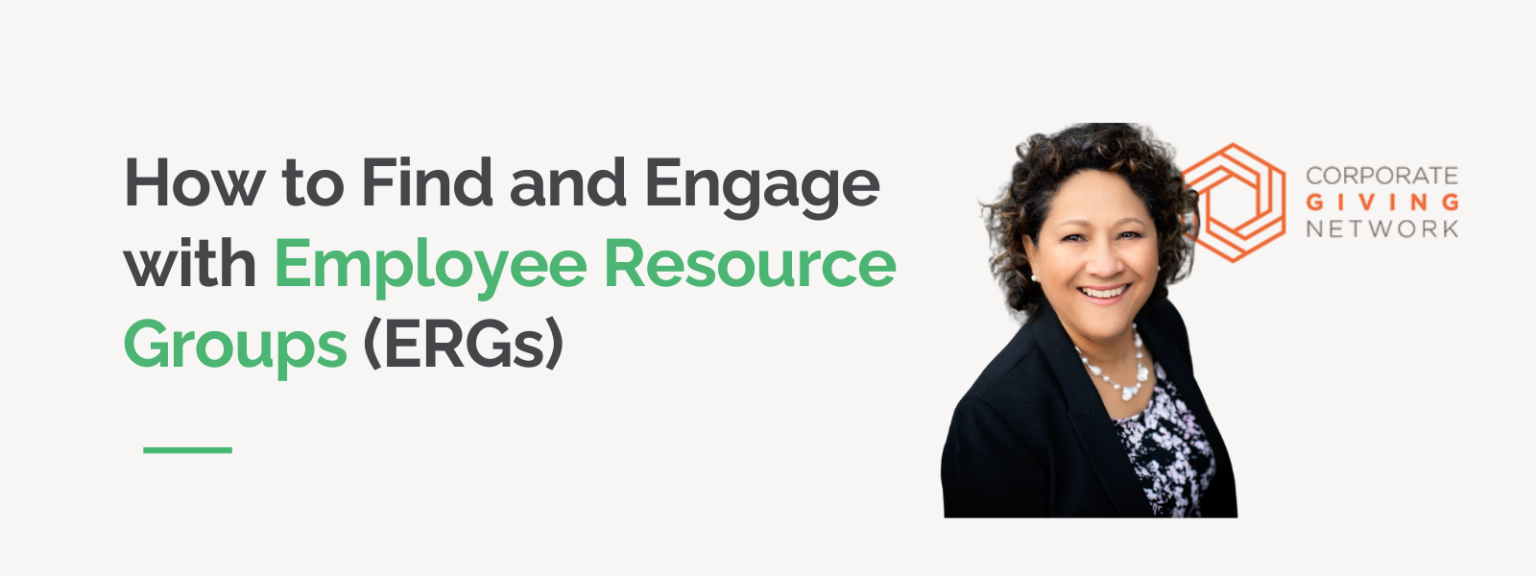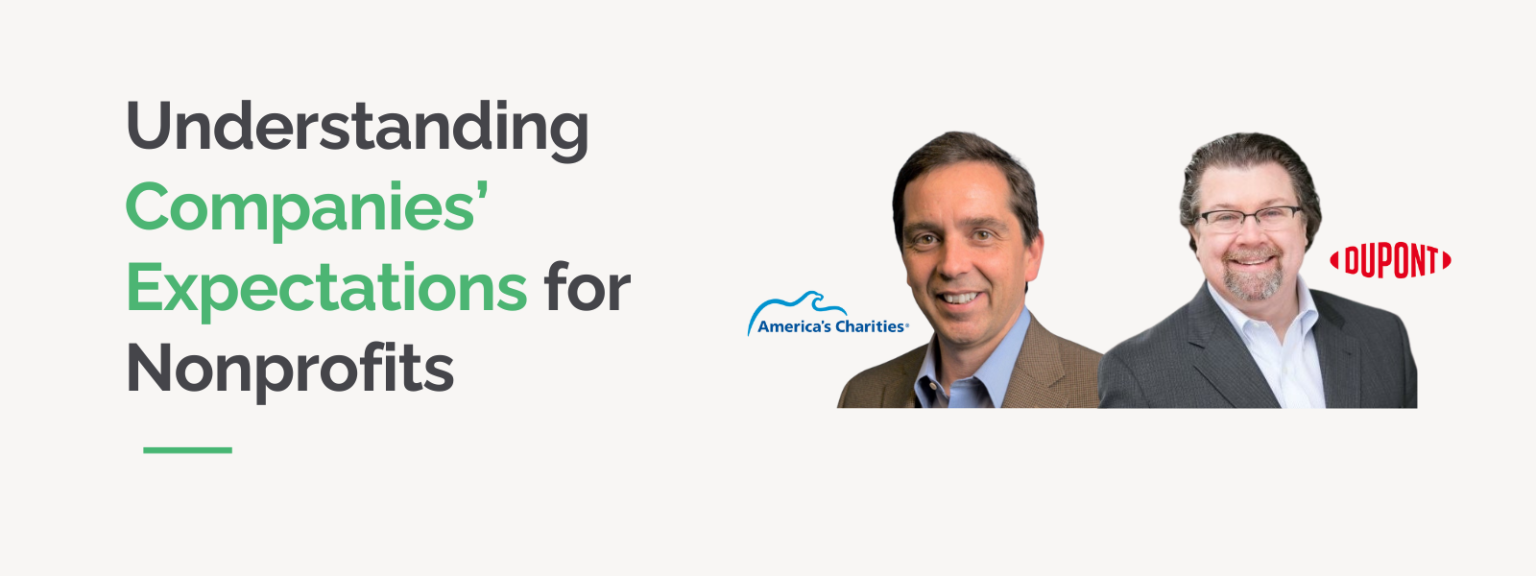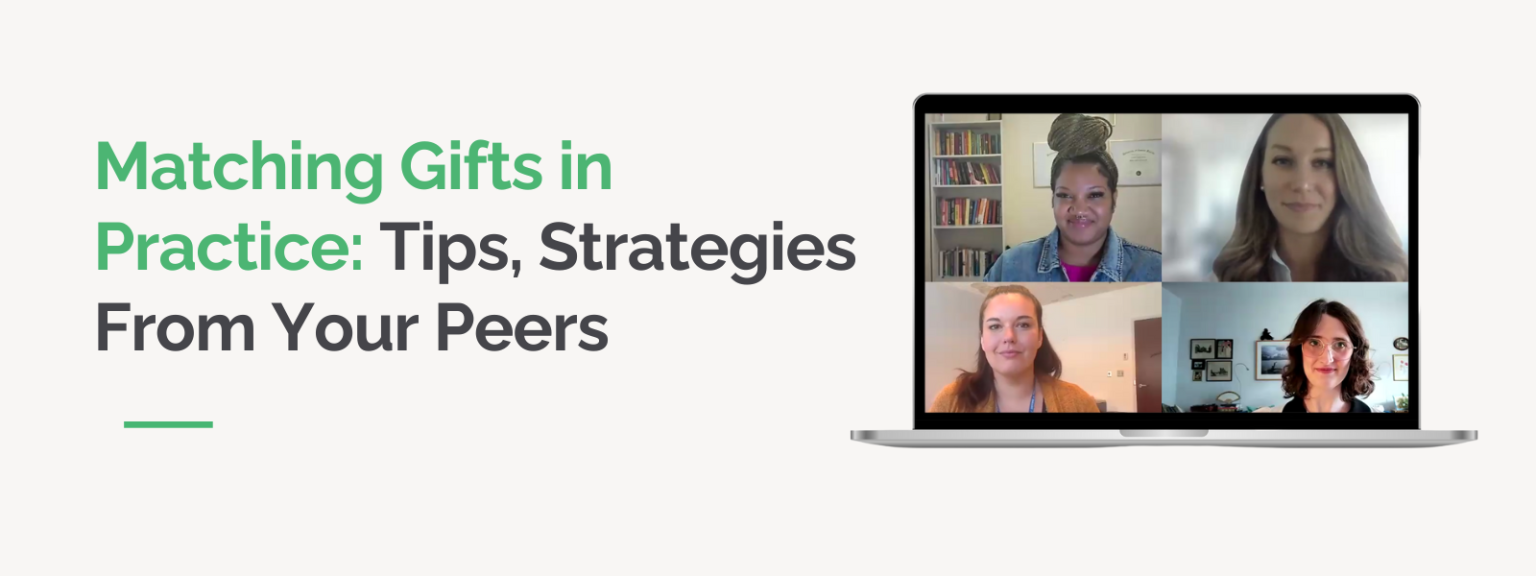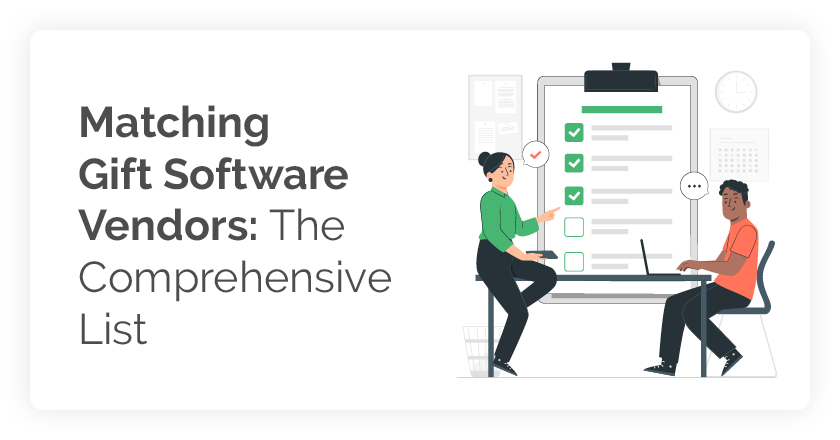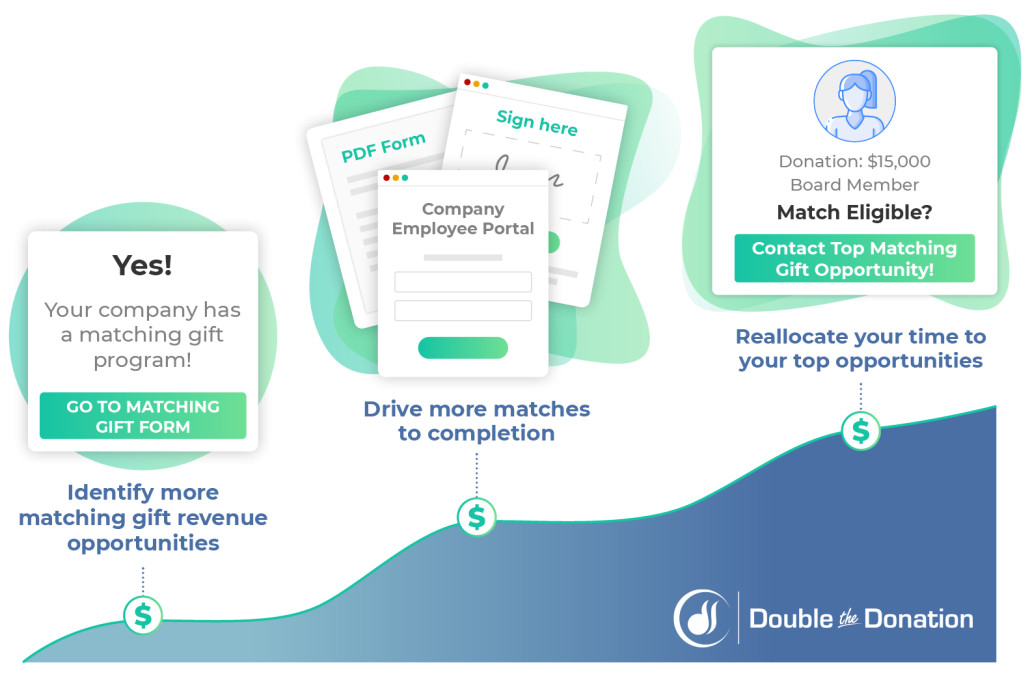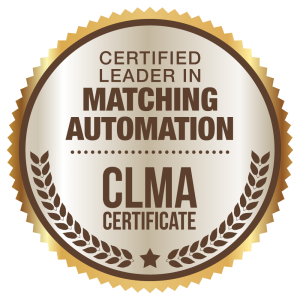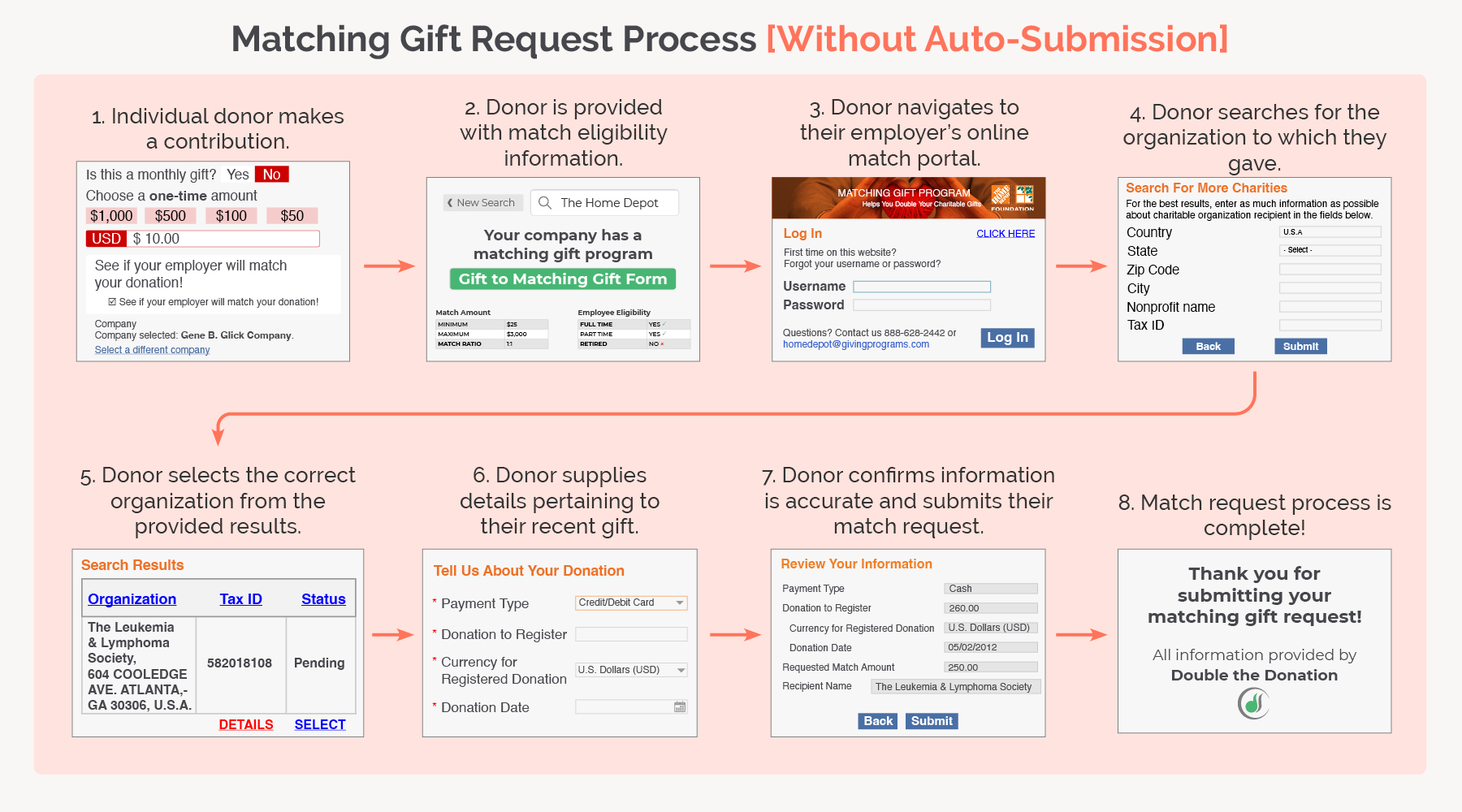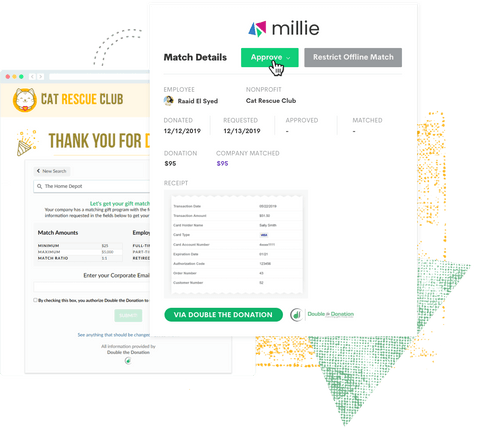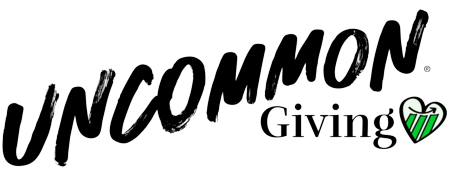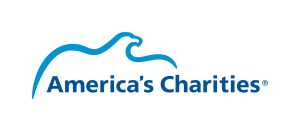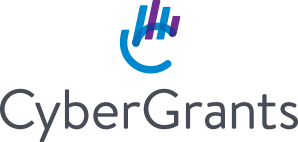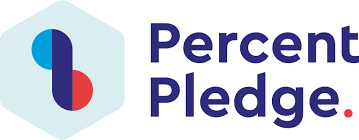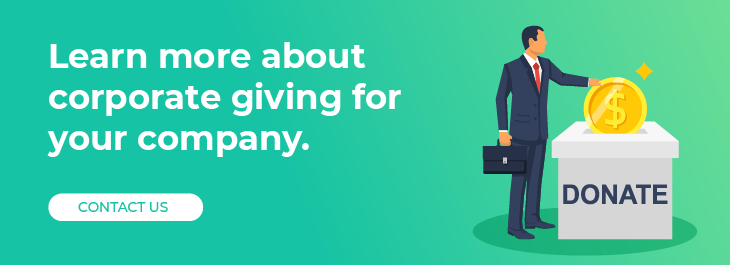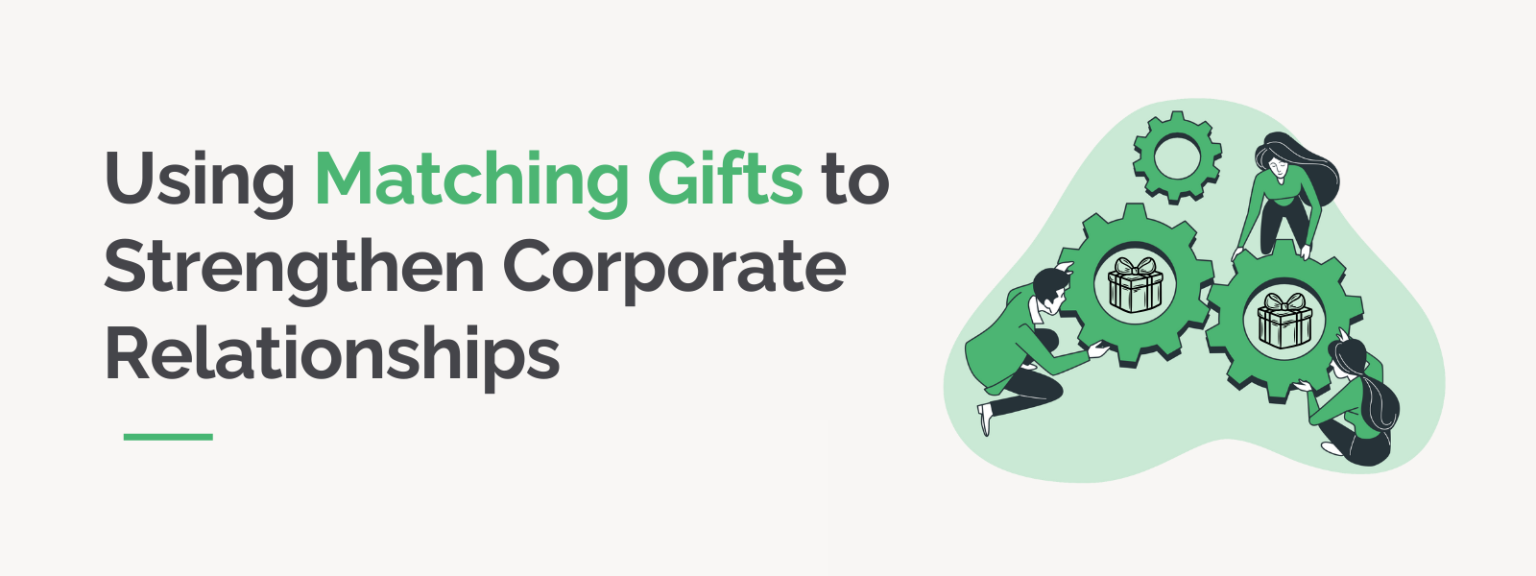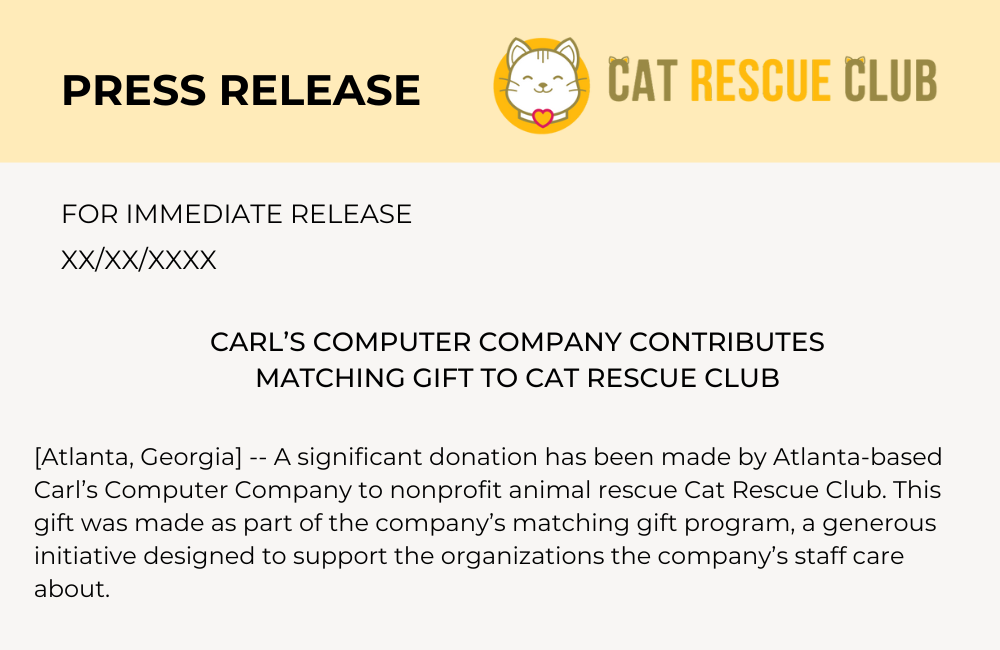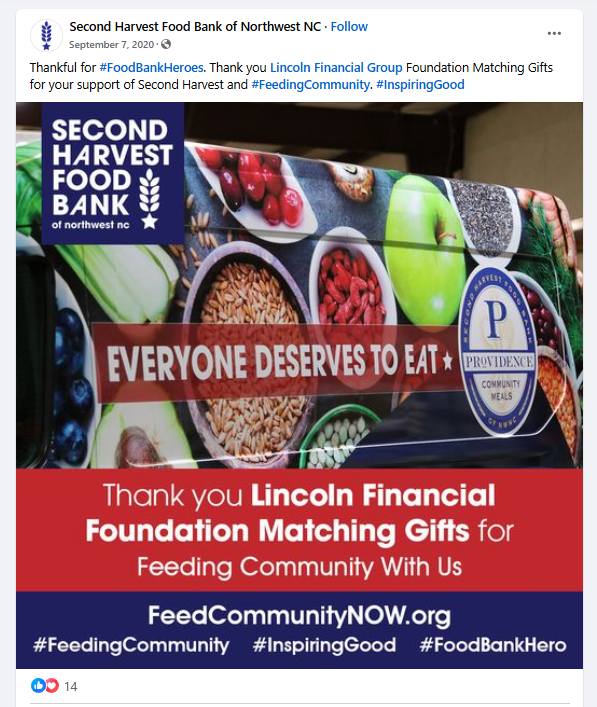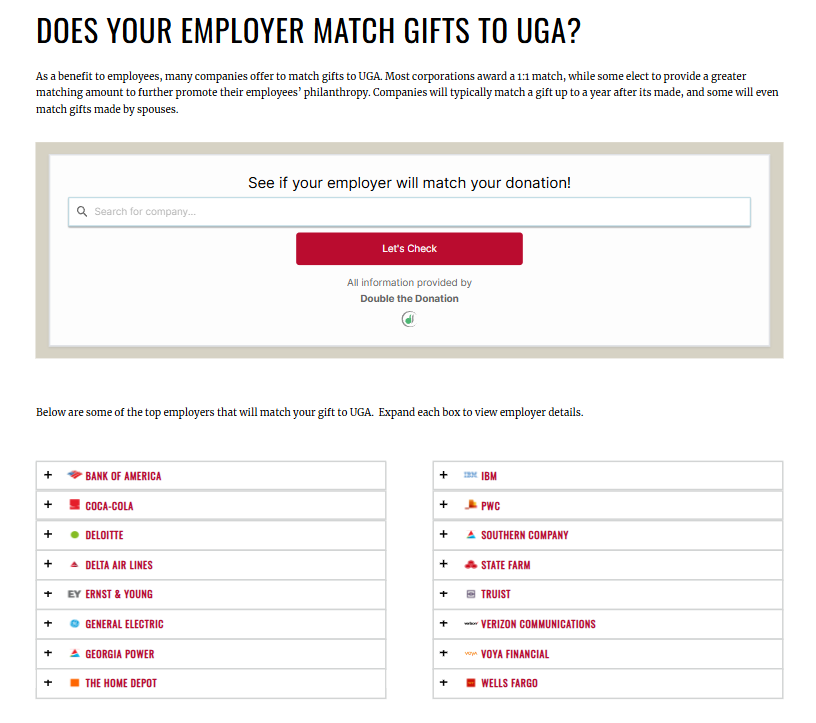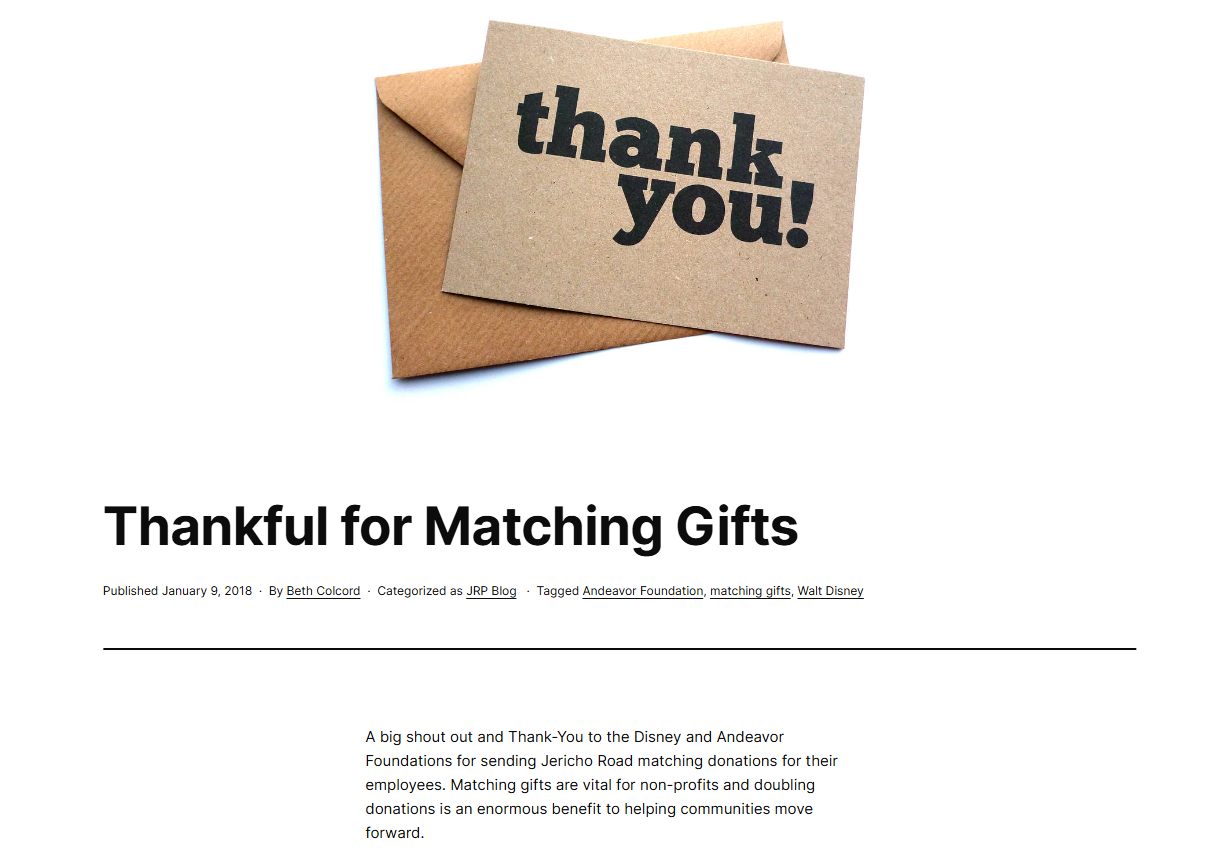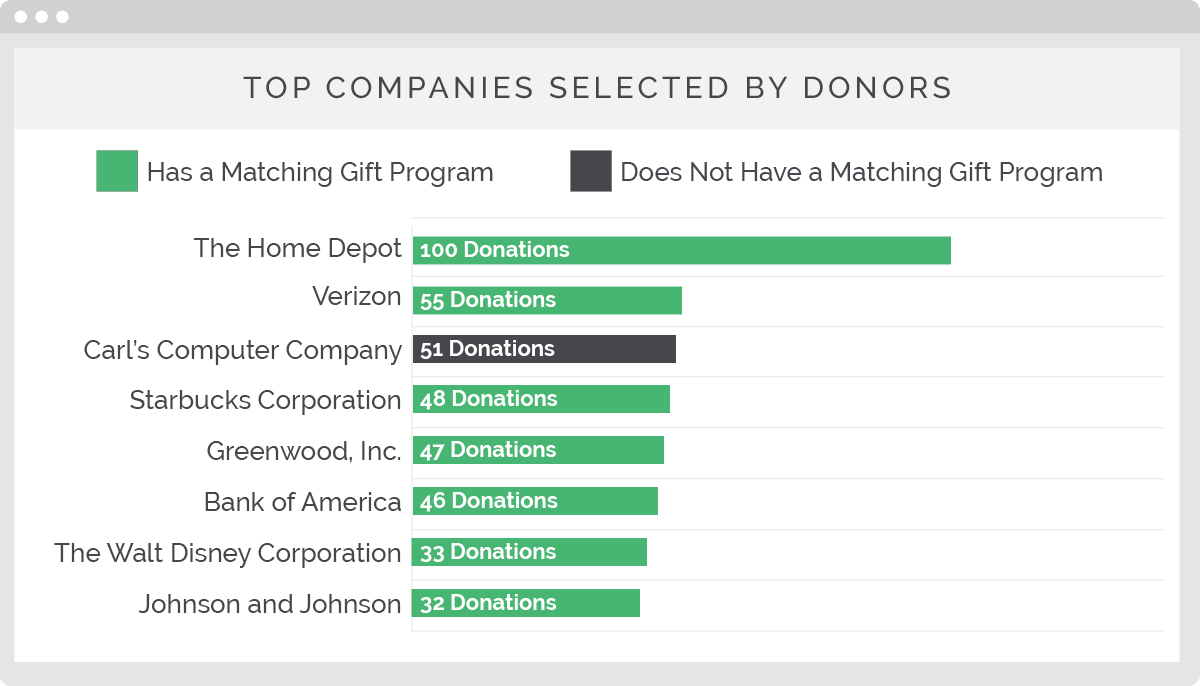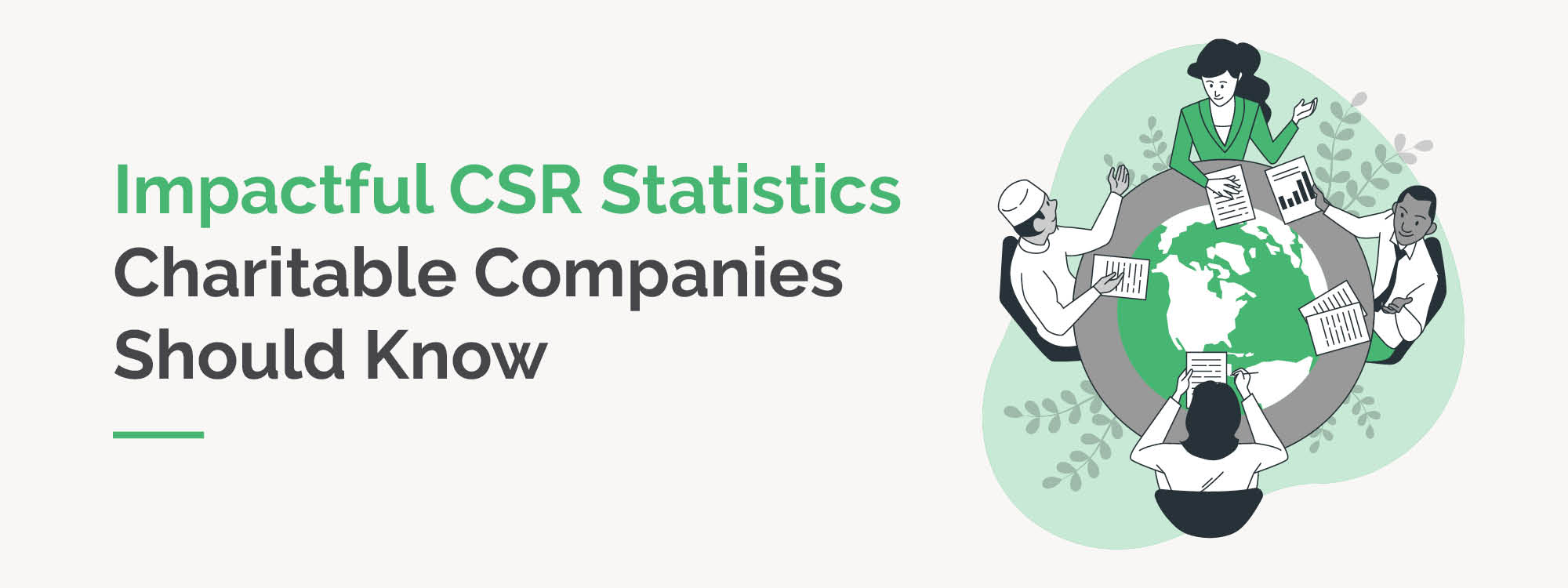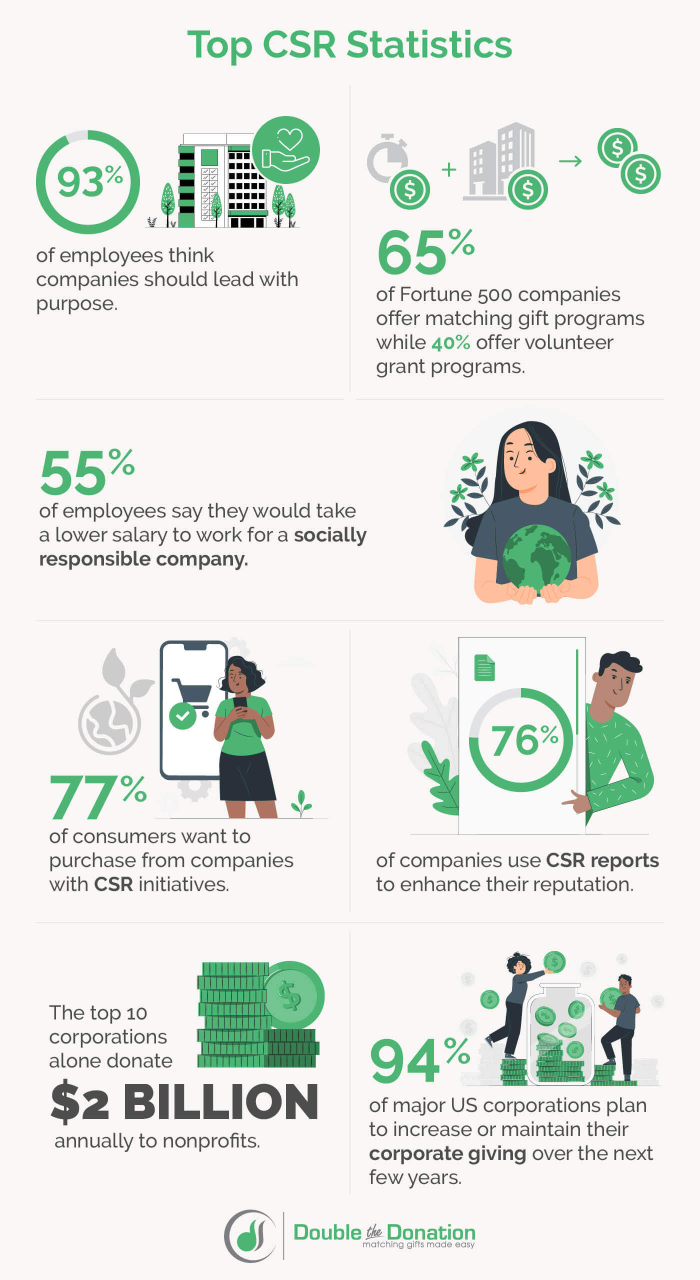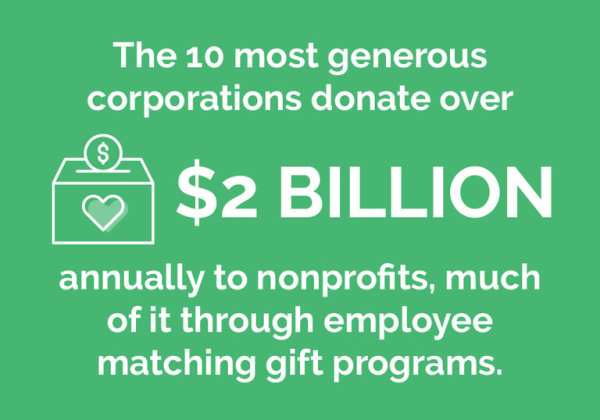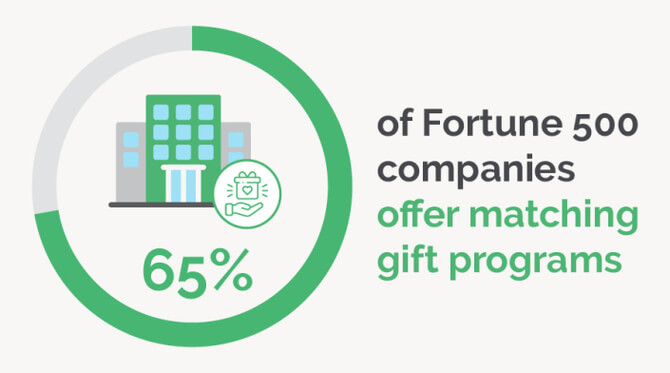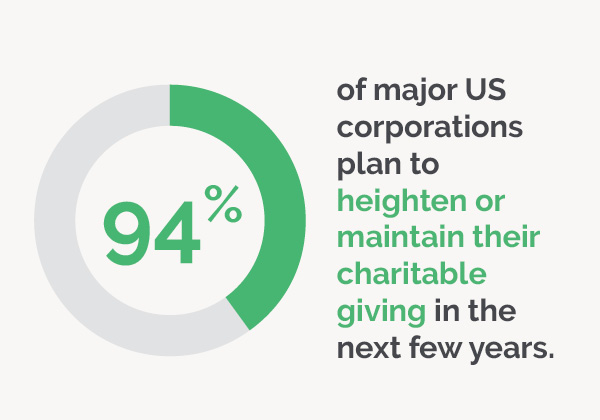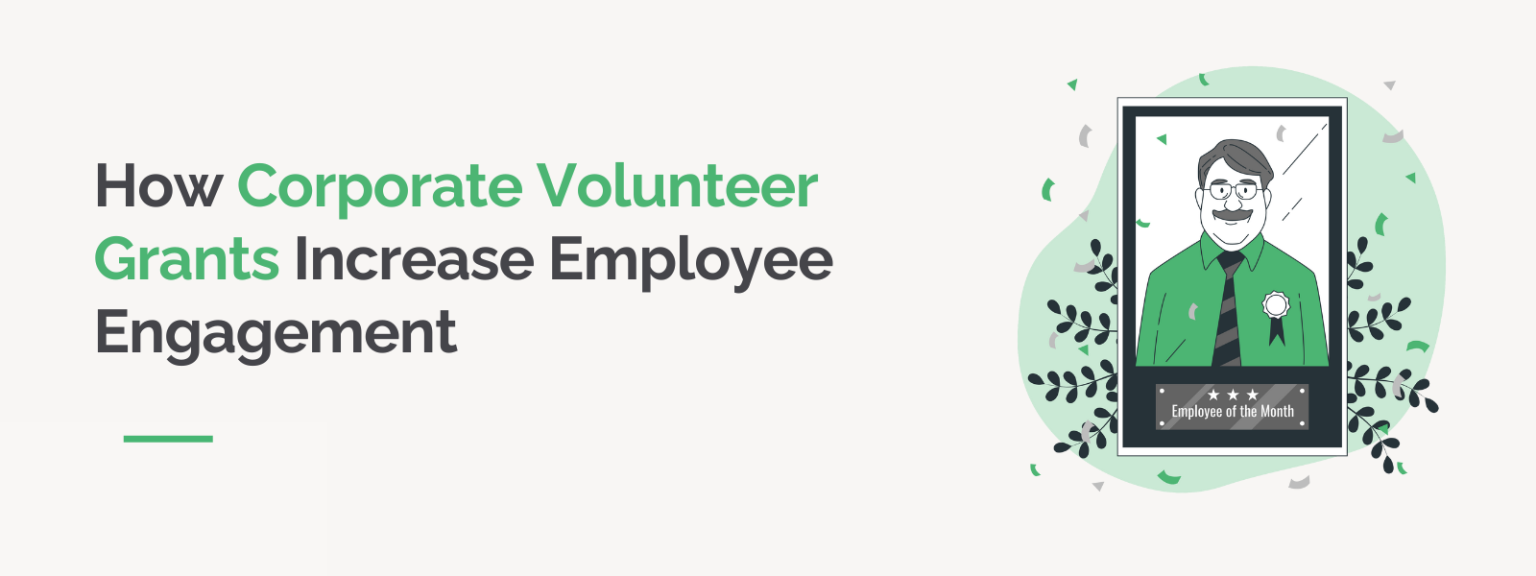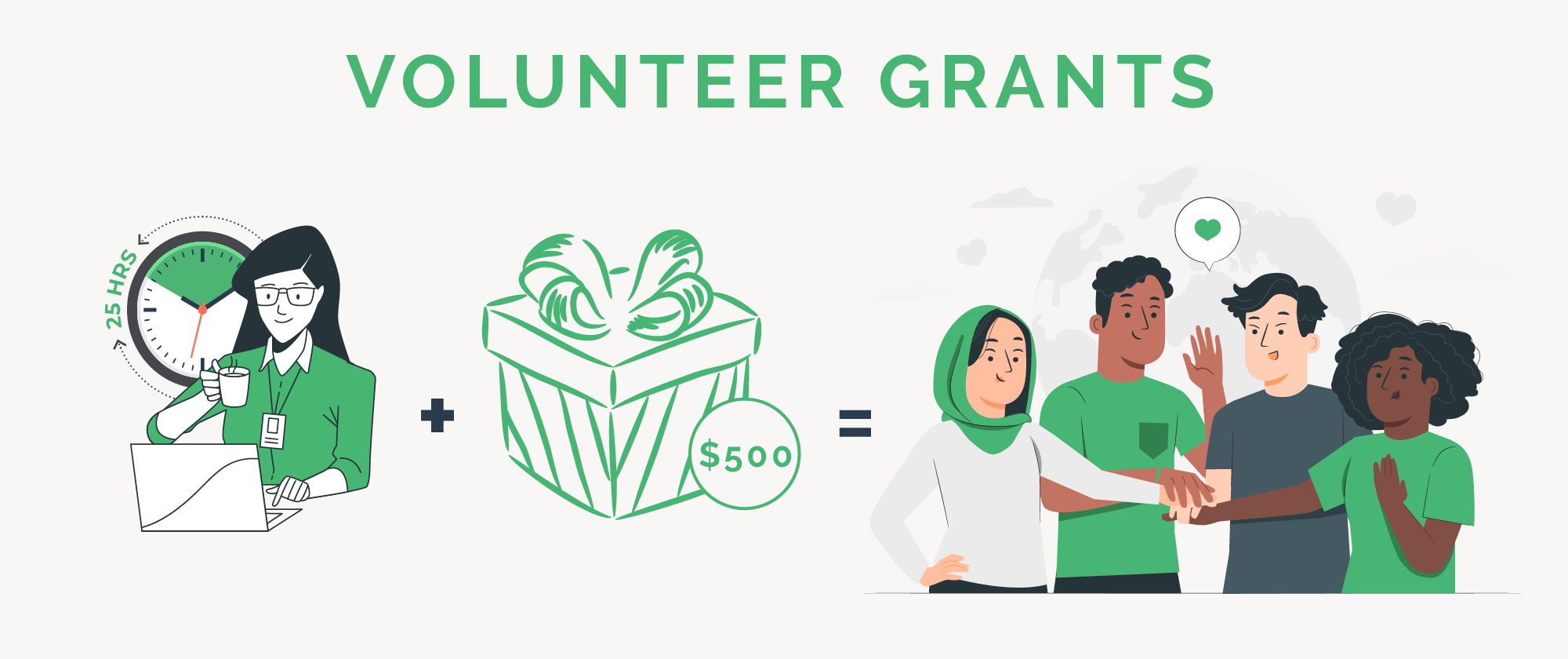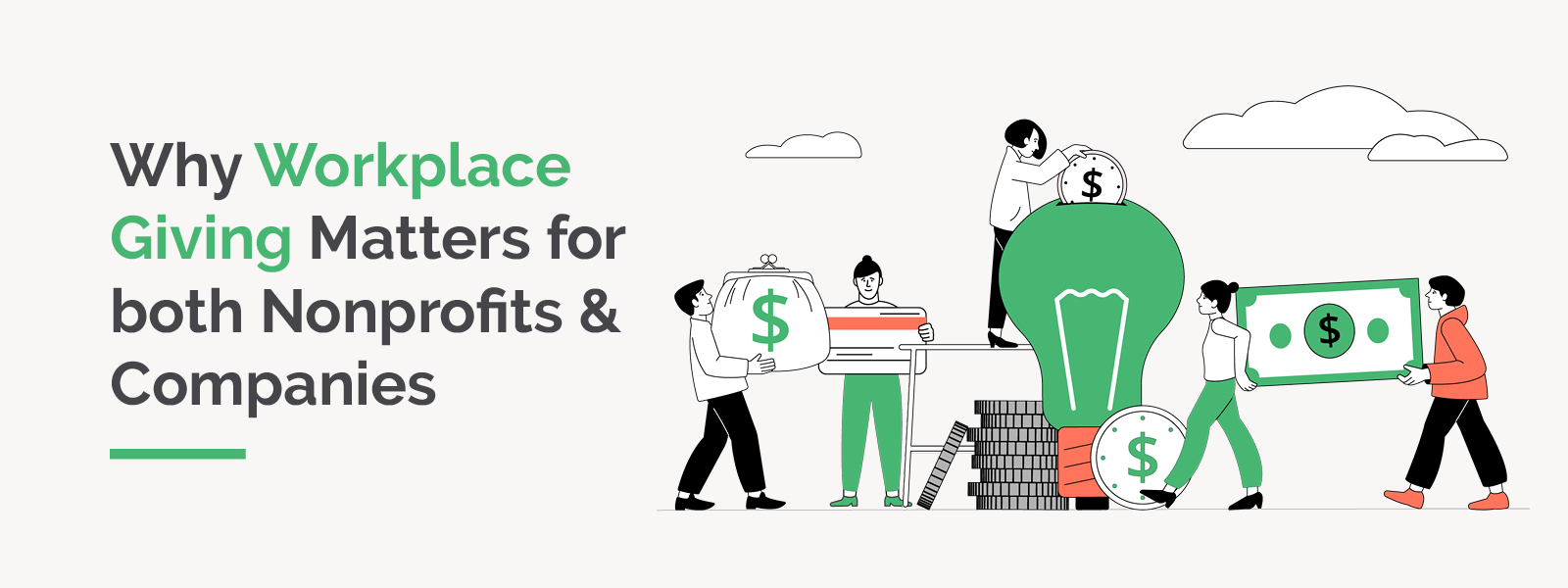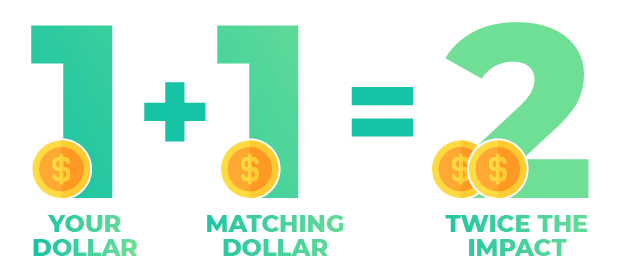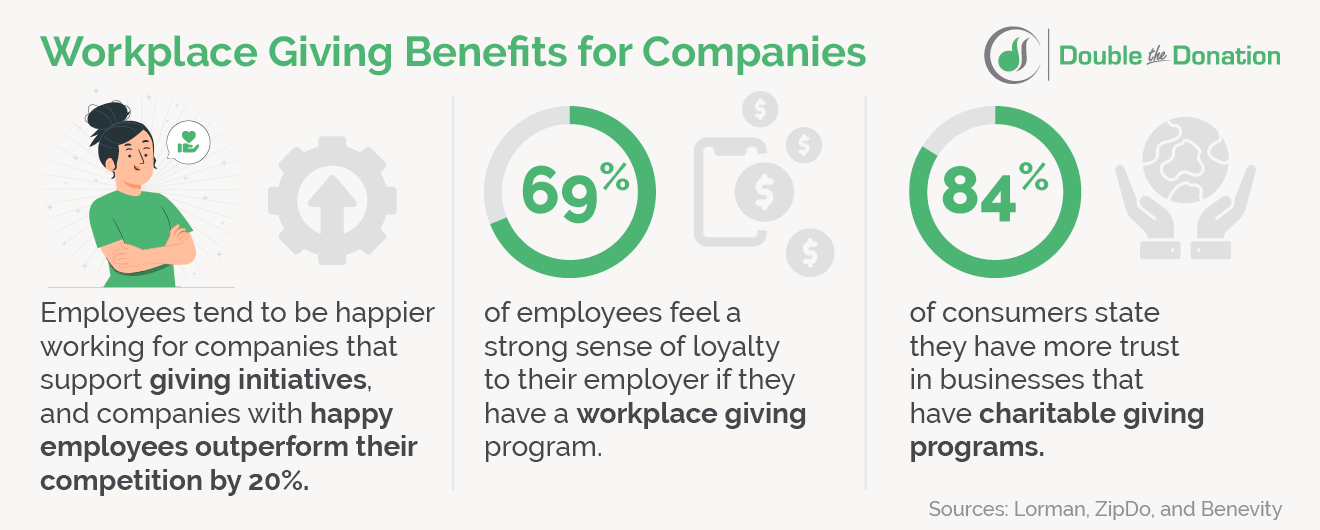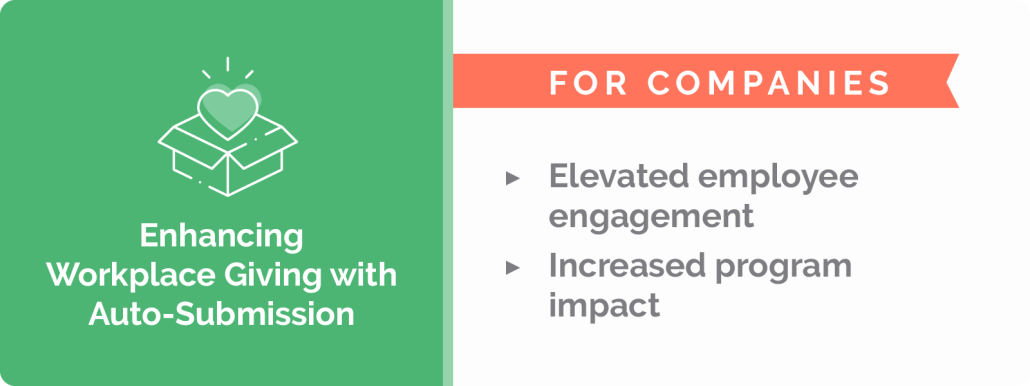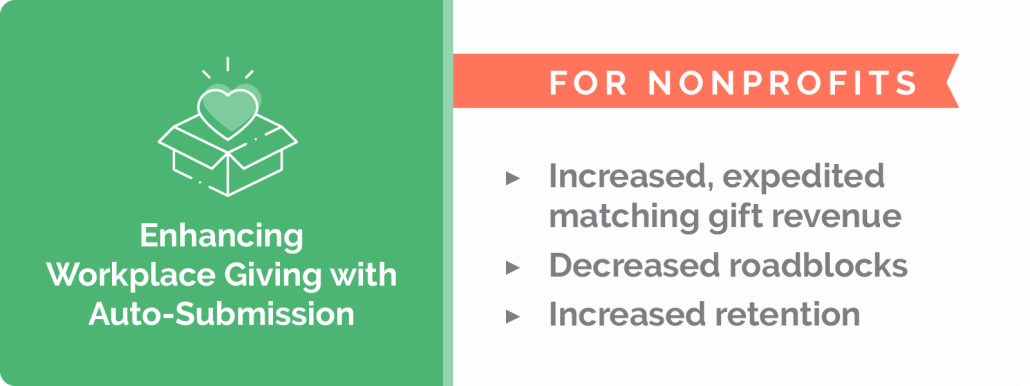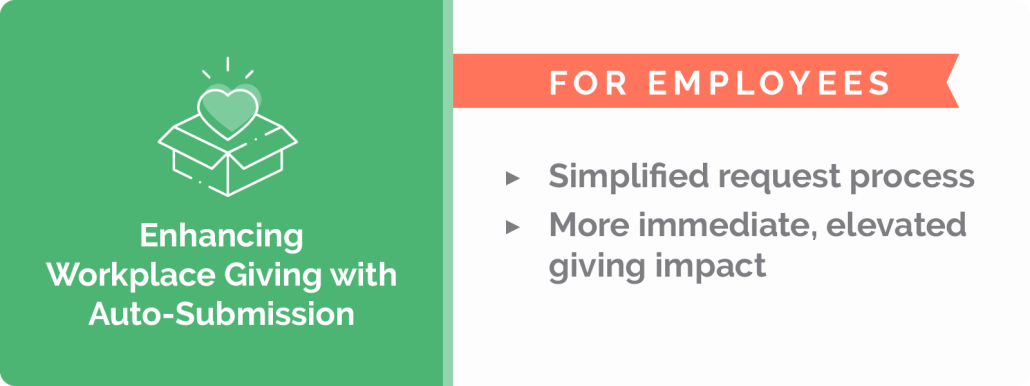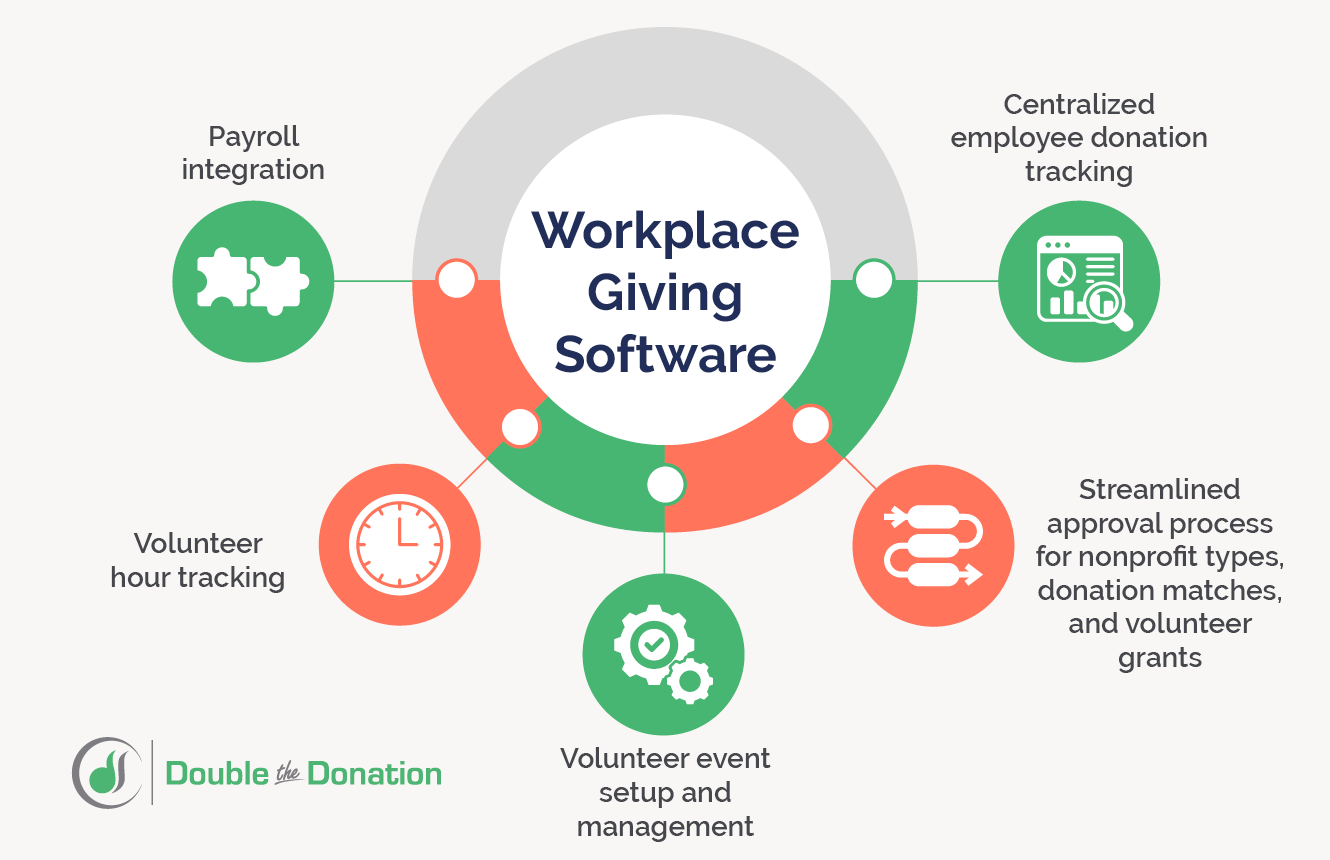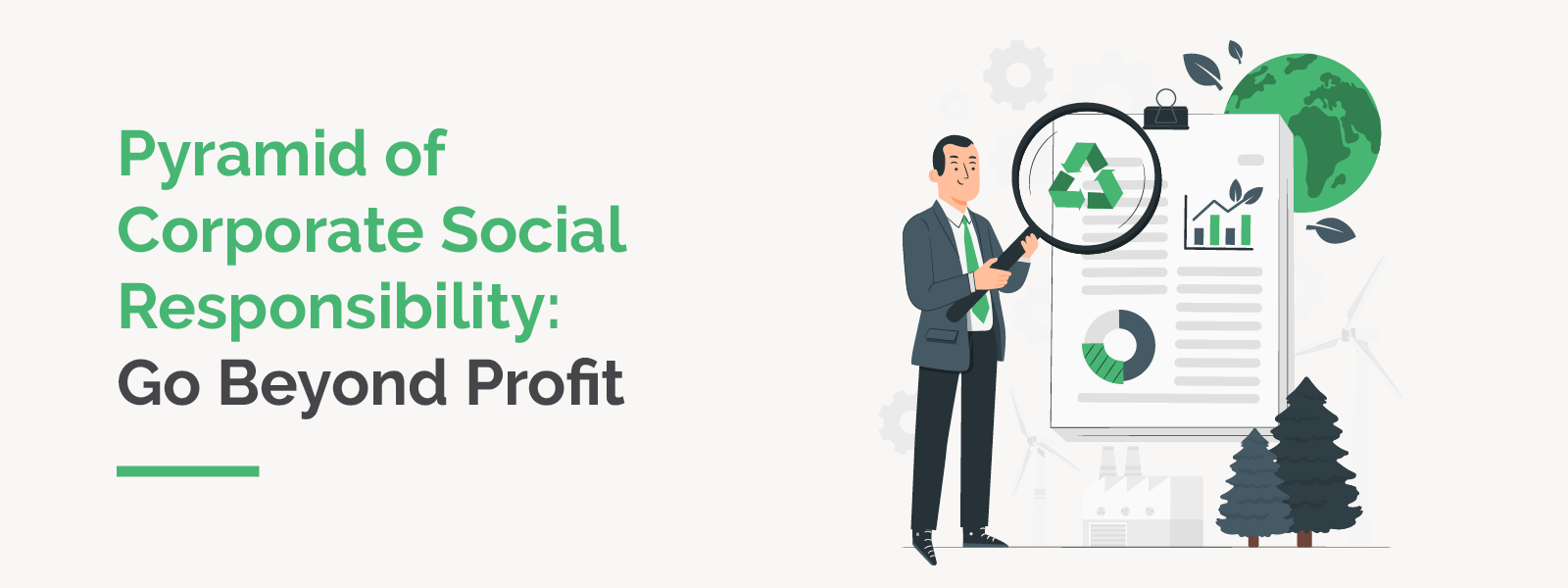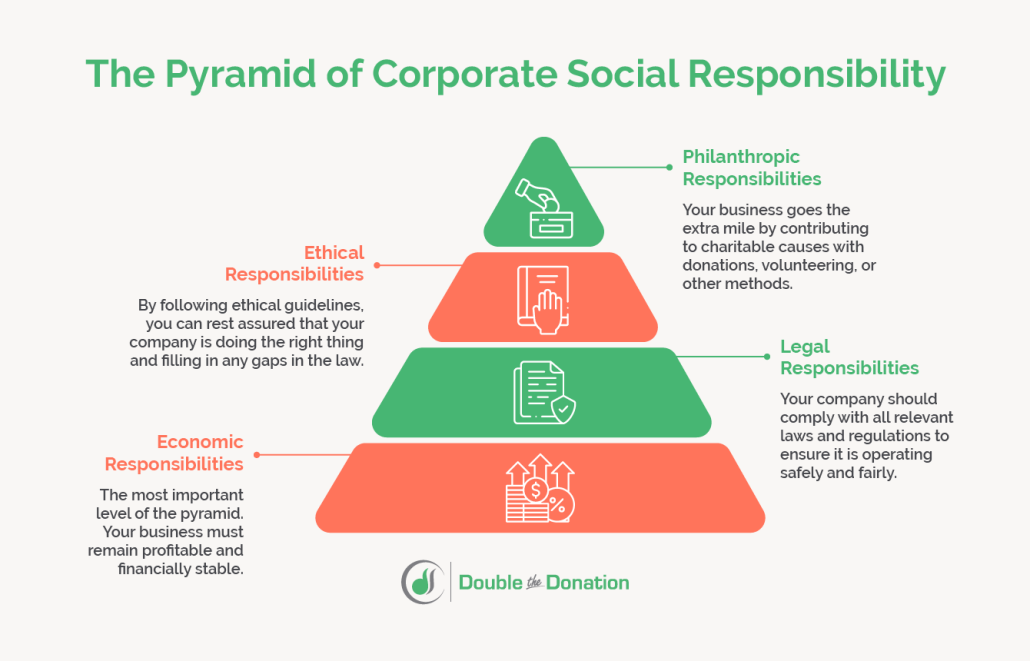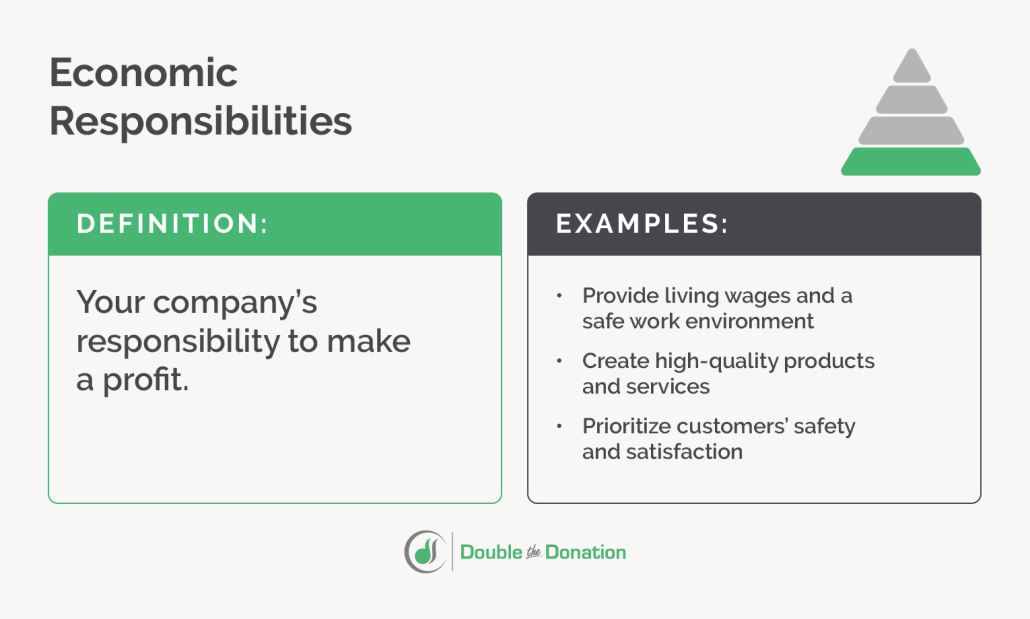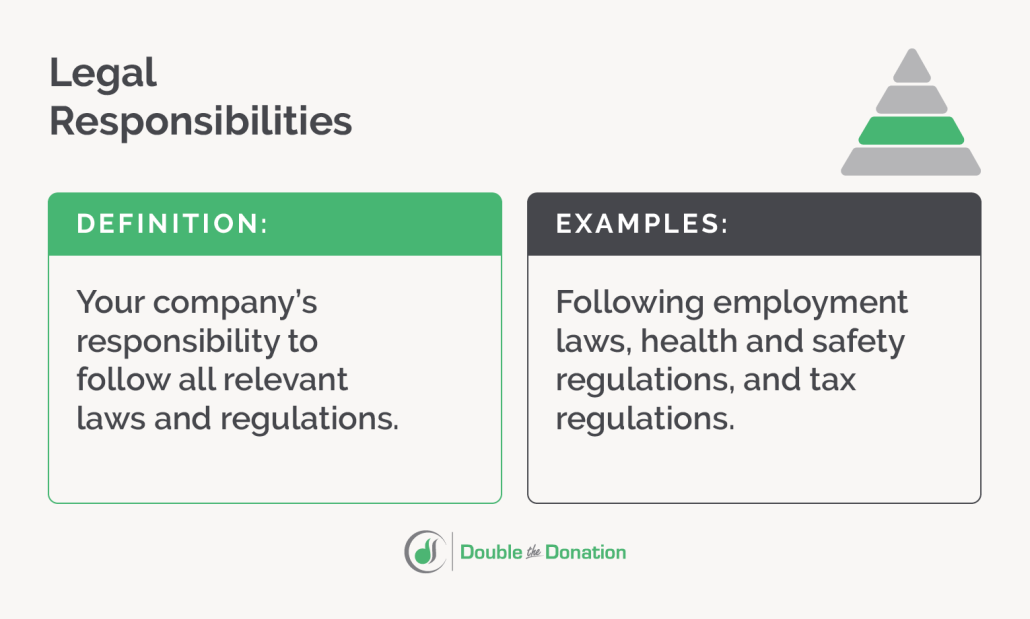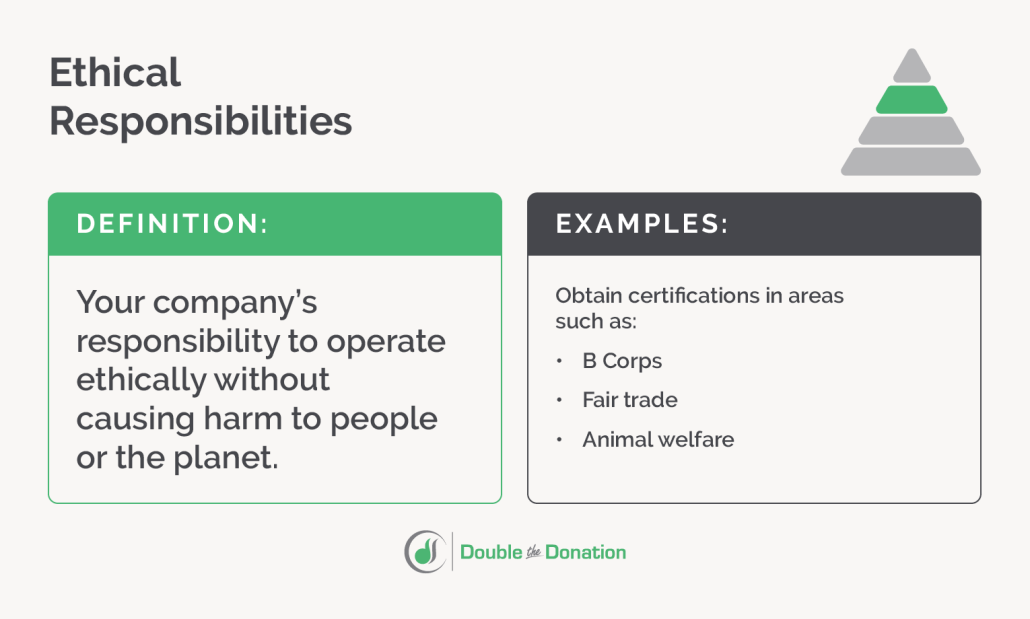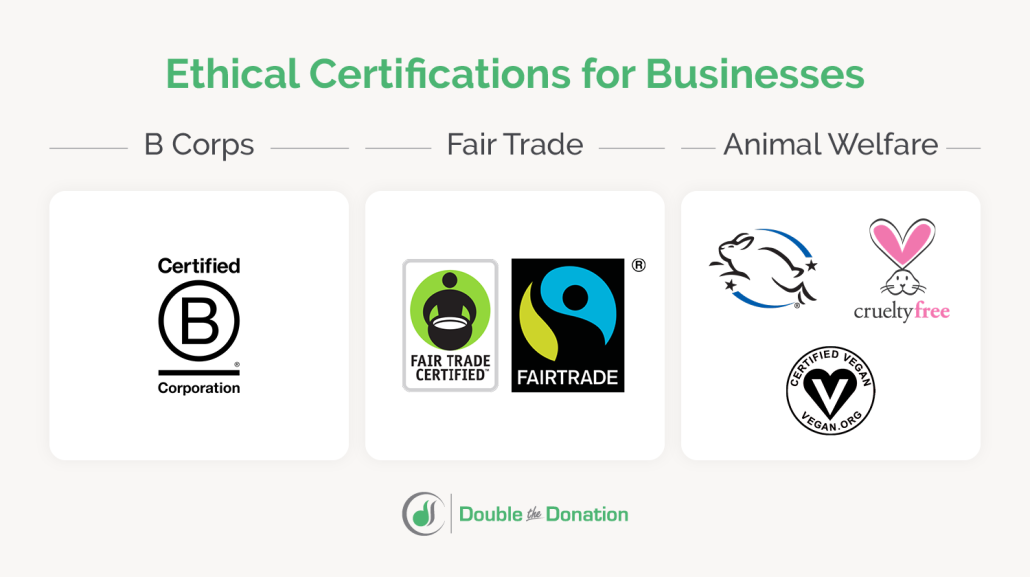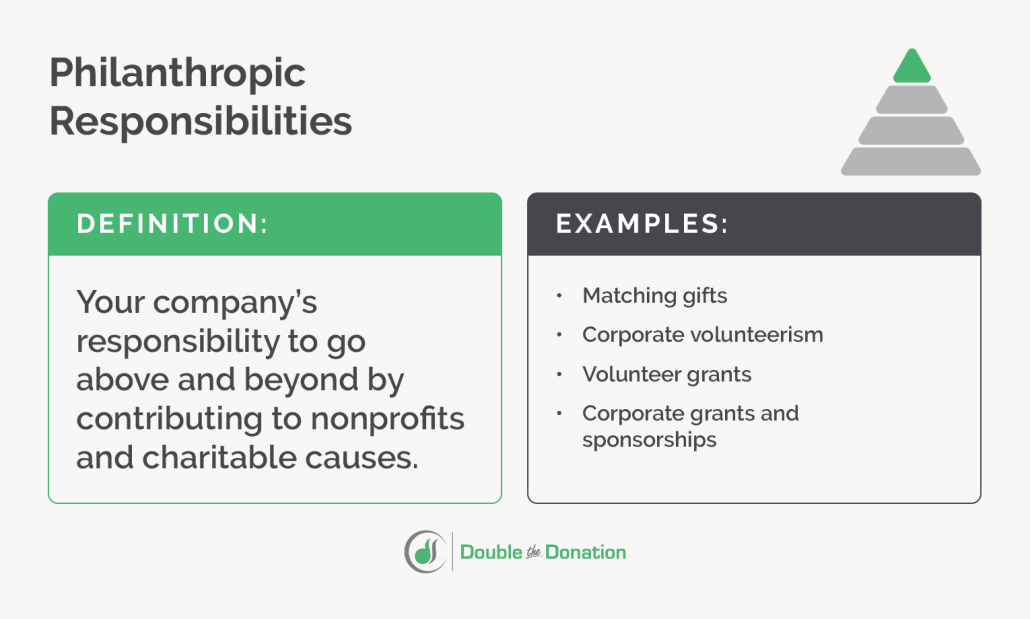Understanding Companies’ Expectations for Nonprofits
/in Corporate Sponsorships, Corporate Consulting, Learning Center /by Adam WeingerMatching Gifts in Practice: Tips, Strategies From Your Peers
/in Corporate Consulting, About Double the Donation, Learning Center /by Adam WeingerMatching Gift Software Vendors: The Comprehensive List
/in Lists and Rankings, Corporate Consulting, Learning Center /by Adam WeingerWhether your company is managing a corporate giving program or your nonprofit is seeking matching gift revenue, corporate philanthropy can be tricky to master.
For businesses, creating an effective matching gift program entails substantial hard work that will ultimately pay off. For nonprofits, it takes ongoing research to acquire much-deserved matching gift revenue. Nonetheless, corporate social responsibility is a growing, impactful phenomenon.
Matching gift programs are naturally complex, but fortunately, there are several technology solutions on the market. To kick off your research, let’s go through each of these major areas:
If you’re not already familiar with these philanthropic programs, take a look at this comprehensive guide on corporate giving. Otherwise, let’s jump straight into the top matching gift software providers!
1. Top Matching Gift Software Providers for Nonprofits
Corporate giving represents a major revenue opportunity for nonprofits, but researching your donors’ employers can be fairly difficult and time-consuming. Plus, for nonprofits, this process never ends.
Once you initially gather information on local companies’ matching gift programs, your team has to stay up-to-date on the changes made within these programs. You also have to be constantly on the lookout for new employers each time a donor submits a gift.
This may be doable for very small nonprofits, but as their donor bases grow, staying updated without effective software is virtually impossible.
Why It’s Important for Nonprofits to Use Matching Gift Software
Many donors don’t know how to navigate their employer’s corporate giving process—and some are unaware that their employers even offer matching gift programs at all. For that reason, nonprofits tend to leave a substantial amount of revenue on the table every year.
In fact, an estimated $4-$7 billion in matching gift funds goes unclaimed annually.
Matching gift software not only helps spread awareness around matching gift programs but also helps guide donors through the process in an easy and intuitive way. Any size nonprofit can benefit from a matching gift database—no matter how small or large. Without a comprehensive system, your nonprofit will inevitably overlook these major revenue opportunities.
So how do you choose the right matching gift software? Be sure to invest in a solution that’s frequently updated, comprehensive, and easy to use, such as the leading matching gift solution: Double the Donation.
Double the Donation
Double the Donation is the complete end-to-end matching gift solution that automates the majority of the process. The platform pulls directly from Double the Donation’s extensive matching gift database, giving you the most comprehensive coverage of matching gift programs.
Here’s how it works to simplify corporate giving for nonprofits:
- An individual submits a donation. When donors enter their information into your donation forms, the platform automatically identifies their matching gift eligibility by searching for the details they provide in a database of corporate philanthropy programs. This may include email domains or employer information.
- Double the Donation automates your follows up. Depending on the donor’s eligibility, the platform automatically triggers customizable follow-up emails to these donors. If they’re eligible for a matching gift, they will be prompted to submit a request. If their eligibility is unknown or they are ineligible, they will be prompted to double check using the search tool.
- The platform tracks matches to completion. Double the Donation enables customizable tracking so you know where your donors are in the match process.
Benefits of using Double the Donation include:
- More matching gift opportunities. Double the Donation allows you to automatically determine matching gift eligibility among your donors, which means more matching gift requests will be successfully submitted.
- More matches driven to completion. The platform directs donors to their company’s matching gift forms right after the donation has been made and continues to follow up afterward. This means more submissions will be completed and bring in exponentially more matching gift revenue for your organization.
- More time to focus on top opportunities. Because Double the Donation automates every matching gift opportunity, big or small, your organization can focus its efforts on the most valuable match-eligible donations.
- Closer relationships with corporate partners. Double the Donation is also the only matching gift software that offers custom matching gift program management functionality (where a company commits to matching donations made by employees to a specific nonprofit). This feature empowers organizations to facilitate unique or one-off match opportunities directly with the companies in their network, and the ease with which the programs are managed from both sides leads not only to more matching gift opportunities but to increasing donor reach, positive fundraising outcomes, and deepening long-term partnerships!
*As a note, this feature is designed specifically for fundraisers looking to manage custom matching gift initiatives—Double the Donation does not work directly with corporations. If you’re a company interested in creating a matching gift program, contact us, and we’ll share information about our corporate vendor partners. - Less effort for donors to get involved. Donors love elevating their giving impact with matching programs, but complicated processes can lead to eligible matches going unclaimed. Double the Donation helps simplify the experience for qualifying donors, including with new streamlined auto-submission functionality.
Double the Donation will ensure your organization doesn’t leave large sums of matching gift revenue on the table. The platform essentially serves as your own matching gift team, automating the process so your staff can focus on the most important thing: serving your mission.
What to look for: Fundraising integrations
Unlike many matching gift software solutions for nonprofits, Double the Donation’s matching gift software integrates with more than 100 of the leading fundraising platforms. In other words, if your organization already leverages specific donation or CRM software, you won’t have to worry about transferring your donor data between platforms.
The system also has state-of-the-art security (as illustrated by its SOC 2 Type II Compliance) that will protect all of your donors’ data and help your team gain better insight into your revenue opportunities.
Double the Donation’s matching gift integrations include:
- CRMs, such as Blackbaud (Raiser’s Edge NXT) and Salesforce
- Peer-to-peer fundraising platforms, such as Classy and DonorDrive
- Donation software, such as Luminate, Convio, Funraise, and iModules
- Corporate giving software, such as Millie, POINT, and Selflessly
These integrations allow you to continue using the fundraising software you already leverage while also sending the data through Double the Donation’s platform so you can automatically identify new matching gift opportunities.
Double the Donation is the next evolution of advanced matching gift tools for nonprofits. If your organization isn’t using dedicated matching gift software, there’s no doubt that you’re missing out on major opportunities.
Interested in learning more about smart matching gift fundraising and best practices for leveraging Double the Donation to your greatest potential? Check out Double the Donation’s Matching Gift Academy here!
2. Matching Gift Software Vendors for Companies
If your company doesn’t already have a philanthropic program in place, there’s no time like the present to get started! After all, there are innumerable benefits to having these programs, including heightened employee engagement and a positive company reputation.
If you already have a match program in place, your company may be considering switching to an electronic matching gift system. Not only does that save valuable time, but it also ensures there aren’t any gaps in your guidelines.
Let’s go through each of the leading software vendors for companies:
- America’s Charities
- Benevity
- Bright Funds
- Charityvest
- CyberGrants
- Field Day
- Millie
- Percent Pledge
- POINT
- Selflessly
- SmartSimple
- Uncommon Giving
- YourCause
These vendors deliver everything a company needs to outsource the employee matching gift administration process, volunteer grants, disaster relief, and broader workplace giving programs. And for your convenience, we’ve separated them out based on a key distinguishing factor—whether they offer auto-submission functionality.
What to look for: Is the matching gift software CLMA-certified?
For the best results, companies in the matching gift software buying process should prioritize CLMA-certified solutions in order to provide optimal encounters for their employees and the organizations they support. What does that mean?
Platforms with the official CLMA Certificate have been deemed Certified Leaders in Matching Automation, providing the most streamlined and intuitive matching gift experience for their users. This, in turn, encourages higher rates of employee participation and reduces the administrative burden for companies and nonprofits alike.
What to look for: Does the matching gift software offer auto-submission?
Traditionally, donors looking to participate in matching programs have been required to submit their donation to a nonprofit organization, then complete a separate request process with their employer to secure the corporate match. This separate request often asks for information about the receiving organization, specific donations, and even the employee themselves, and it’s often a critical roadblock keeping employee donors from completing their matches.
Today, many companies are rolling out matching gift auto-submission abilities, which allow donors to submit their match requests directly from their favorite organizations’ donation confirmation pages with a single click.

Let’s take a look at some of the breakthrough matching gift software providers that are empowering companies and their employees with this functionality;
Field Day

With Field Day, companies can:
- Match employee donations to eligible nonprofits, increasing the impact of employee generosity.
- Organize and track employee volunteerism through company-sponsored events and initiatives.
- Offer location-based giving opportunities to connect employees with causes in their communities.
- Launch custom giving campaigns to align charitable efforts with corporate social responsibility (CSR) goals.
Field Day’s platform empowers businesses to create a culture of giving while ensuring that employees are actively engaged in philanthropy. Additionally, their integration with Double the Donation’s matching gift software allows for seamless auto-submission of matching gifts, reducing administrative work and maximizing donations.
Millie
Millie provides workplace giving tools for all by allowing companies to create simple and flexible social impact programs on a budget. Their platform brings the power of a giving wallet to everyday donors by providing financial tools that allow for easy, simple, and strategic giving.
Millie allows companies to:
- Match employee donations
- Manage employee volunteerism by creating events and tracking impact
- Build giving campaigns
- Gift charitable dollars to employees and customers
Millie’s workplace giving platform is designed to provide a comprehensive and affordable solution for companies of all sizes so that reaching CSR goals is achievable for all. Plus, they integrate with Double the Donation’s matching gift solution to offer innovative auto-submission for their corporate clients.
Learn more about Millie on their website here or check out our case study to see their matching gift auto-submission in action!
POINT

As an innovative corporate giving provider, POINT enables businesses to:
- Manage matching donation campaigns and initiatives
- Manage employee volunteerism
- Organize virtual volunteer opportunities
- Co-host volunteer opportunities with local nonprofits
- Fulfill tangible nonprofit needs through in-kind giving
- Automatically track volunteering and giving statistics and reporting
- Track impact of workplace giving initiatives
Plus, when companies purchase a subscription to POINT, they can gift the nonprofit POINT platform to nonprofits for free. Companies can collaborate with nonprofits on the same platform and give nonprofits the tools they need to find and manage volunteers seamlessly, saving them up to 15 hours per week.
Not to mention, POINT now offers matching gift auto-submission to make matching gifts as simple as possible for companies, donors, and nonprofits alike.
Selflessly

Selflessly helps businesses:
- Donate to millions of local and national charities
- Provide simple employee giving processes
- Match employee donations
- Report on giving and impact
- Promote employee engagement
- Locate and manage volunteer opportunities
- Track volunteer time off
If you’re looking for a powerful yet affordable matching gift solution for your business, Selflessly is a great way to go. As an added bonus, they even partner with our matching gift automation tool to further streamline the giving and matching processes for employers and employees alike through matching gift auto-submission abilities!
Learn more about Selflessly on their website here or read our case study to see how this matching gift vendor is changing the game with auto-submission!
Uncommon Giving

Uncommon Giving offers:
- Matching gift programs that allow employees to amplify their contributions with company-sponsored donations.
- Donor-advised funds (DAFs) to facilitate long-term charitable giving and financial planning for employees.
- Volunteer tracking and incentives to encourage and reward employee engagement in nonprofit work.
- Charitable gifting tools that enable businesses to distribute funds to employees and customers.
By offering a holistic approach to workplace philanthropy, Uncommon Giving helps businesses align their giving initiatives with employee values while maximizing social impact. Meanwhile, their integration with Double the Donation’s matching gift software further enhances their corporate matching capabilities, ensuring a seamless and efficient donation-matching experience.
Learn more about Uncommon Giving!
Does Not Yet Offer Matching Gift Auto-Submission
These other CSR platforms can offer excellent features and functionality regarding matching gift program management for companies, though they have not yet built out auto-submission capabilities with Double the Donation. This means that employees will be required to complete separate request processes to participate in their companies’ giving initiatives.
However, matching gift auto-submission is the future of corporate gift-matching, so keep an eye out as more of these providers shift to automatic submissions as well.
America’s Charities
America’s Charities offers an entire suite of tools for companies. Their most comprehensive solution, Engage, is an end-to-end giving and corporate social responsibility (CSR) solution that offers a holistic view of your global impact.
The platform provides a comprehensive and flexible solution to help your company streamline community programs and maximize your social investment. Best of all? You can manage all of your corporate philanthropy and giving programs from one place.
Engage helps organize:
- Corporate philanthropy, grants, and sponsorships
- Donation matching
- Employee workplace giving
- Employee engagement
- Volunteer programs
You can also track your goals easily and share eye-catching reports and dashboards using real-time data. Unfortunately, however, Engage does not currently offer matching gift auto-submission capabilities.
Learn more about America’s Charities!
Benevity
Originally founded in Canada in 2008, Benevity has rapidly developed a major presence with companies based in the United States as well.
This workplace giving platform strives to create compelling corporate giving programs that help companies attract, retain, and engage employees. In addition to a matching gift program, the vendor allows businesses to implement other philanthropic programs, such as volunteer grants and charitable gift cards to motivate employees to generously give.
Through Benevity, corporations can evaluate their success in making a positive impact on their communities. That way, they can adjust their efforts to create the best possible giving program. However, Benevity has yet to offer matching gift auto-submission functionality.
Bright Funds
Bright Funds is a leading provider of corporate giving software as a service for workplace giving, volunteering, and grants management. With nearly a decade of experience, Bright Funds helps companies of all sizes multiply their impact through an intuitive, comprehensive corporate social responsibility platform.
Companies can build a culture of giving and grow their employees’ impact with a matching gifts program on Bright Funds. Matching rules can be set up with a single click from the admin dashboard. The platform automatically enforces matching rules and budget limits, while ensuring that employees can only donate to vetted, eligible organizations. That gives companies more time to focus on engaging employees to participate and give back to the causes they care about.
With Bright Funds, companies can scale their impact from a single, flexible platform that includes:
- Employee giving (one time and recurring donations)
- Support for 1.8 million global nonprofits and 100 countries
- Donation matching
- Employee engagement
- Full volunteer program management with a preloaded list of over 8 million opportunities
- Integrated grants management
- Managed donations disbursement
- Real-time impact reporting
- Integrations with many payroll, HRIS, volunteering, and other systems
Empower today’s purpose-driven workforce to do good through Bright Funds’ all-in-one corporate responsibility platform. As of yet, however, Bright Funds has not established an auto-submission functionality.
Learn more about Bright Funds!
Charityvest
Charityvest simplifies the giving process for both donors and charities alike. By allowing users to create personal charitable giving funds, donors can securely and freely donate stock and cash to charities without losing a percentage to transaction fees.
Charityvest for Workplaces provides employees with tax-deductible giving accounts and unlocks automatic charitable matching, reporting, and administration for companies. Their workplace giving programs are trusted and utilized by companies nationwide.
With Charityvest for Workplaces, your company can implement fully automated, rules-based grant matching, provide employees with unlimited zero-fee giving to millions of charities, and view real-time reporting on charitable impact. In the future, Charityvest for Workplaces may develop auto-submission functionality, but for now, employees are resigned to partake in manual submission processes.
CyberGrants
For over 20 years, CyberGrants has been a leader in the online grantmaking space. Over time, the company has recorded many firsts through its initiatives, including:
- Developing the first online application
- Providing the first online grants administration tools
- Creating the first online workplace giving and volunteering systems for corporations
A few years ago, CyberGrants merged with the JK Group, which owned the Consiva and Easymatch platforms. Today, it manages employee giving programs for many global companies.
As a flexible philanthropic software platform, CyberGrants provides numerous innovative ways for companies to develop their workplace giving programs. CyberGrants has yet to roll out auto-submission features, still relying on manual requests from employee donors through the system.
Learn more about CyberGrants!
Percent Pledge
Established in 2017, Percent Pledge offers a streamlined workplace giving solution designed to make social impact effortless for companies of all sizes. Through its customizable platform, companies can launch turnkey giving and volunteering programs tailored to their values and employee interests. The platform enables recurring donations, employer matching, volunteer tracking, and access to curated cause portfolios—bundles of vetted nonprofits focused on specific issues like mental health, climate, or racial equity.
One standout feature is Percent Pledge’s built-in impact reporting, which allows companies to track and share the real-world results of their giving initiatives. With dedicated support and personalized experiences, Percent Pledge makes it easy for businesses to boost employee engagement and build purpose-driven cultures—no need for a complicated setup or a large CSR team.
Learn more about PercentPledge!
SmartSimple
SmartSimple offers companies robust tools for grant management, employee giving, matching gifts, volunteer management, and more.
When companies use SmartSimple to manage their workplace giving strategies, they can:
- Approve matching gift requests while following their company guidelines
- Manage volunteer programs and award grants
- Manage in-kind giving
- Monitor impact through detailed reporting
SmartSimple streamlines nearly every aspect of your company’s workplace giving program, making it incredibly easy for employees to participate and boost your CSR impact in the greater community. However, they’ve yet to offer auto-submission functionality, which may be enabled in the future.
YourCause
Through its dedicated corporate social responsibility platform, YourCause helps corporations of all sizes. This platform, called CSRconnect, is a customizable community tool that centralizes employee engagement.
When businesses invest in the CSRconnect platform, they can enable year-round matching gifts, annual pledge campaigns, and more. Additionally, the platform leverages peer-to-peer fundraising. In other words, employees will raise money on behalf of the nonprofits they care about, and companies can match those donations—though they’ve yet to establish a process for matching gift auto-submissions.
As a business professional, you’ve likely heard of the leading CRM platform Blackbaud. YourCause integrates with this major CRM software, meaning you won’t have to spend time transferring your employees’ data. If that’s not convincing enough, the customizable software allows companies and employees to access 300,000+ global nonprofits from 170 countries!
For nonprofits and companies alike, corporate social responsibility is highly influential and catching on rapidly. From the nonprofit perspective, corporate philanthropy means boosting revenue. Not leveraging a matching gift database equates to not fulfilling your matching gift potential.
From the business perspective, corporate philanthropy means developing a brand, promoting a generous workplace, and giving back to the community. However, developing and maintaining a giving program is nearly impossible without the right software.
Now that you know more about specific software solutions, start leveraging this technology in your corporate giving strategy today!
Additional Resources for Nonprofits
- Corporate Matching Gift Programs: Understanding the Basics. Matching gift programs are one of the most common forms of corporate philanthropy. That’s why understanding the basics is essential. Learn more here!
- Corporate Giving Programs: The Ultimate Fundraising Guide. Corporate giving encompasses more than just matching gifts. Find out about other types of corporate philanthropy with this comprehensive guide.
- Top 30 Matching Gift Companies: Find Your Match. Wondering if your donors are linked to any of the top matching gift companies? Check out this comprehensive list.
Additional Resources for Corporations
- Announcing New Matching Gift Auto-Submission Functionality. Make the most of your company’s matching gift programs by enabling auto-submission functionality! The easiest way to do so is by partnering with a corporate giving software provider that integrates with Double the Donation. The simpler the process, the more likely your employees are to get involved.
- Matching Gifts: The Definitive Guide for Employers. A surprising number of companies have not yet started a matching gift program, even though these programs are proven to help retain and engage employees, showcase CSR, and make a positive impact in the community. This guide from America’s Charities will break down the basics and benefits of matching gift programs, explain how to set one up, offer advice from America’s Charities’ team of experts, and more. Take advantage of their years of experience, research, and expertise, and download this guide!
Using Matching Gifts to Strengthen Corporate Relationships
/in Corporate Consulting, Marketing Strategies, Learning Center /by Adam WeingerA common inquiry we receive at Double the Donation centers on how to strengthen relationships with corporations that offer generous matching gift donations. Many organizations wish they had more ways to reach out to these businesses post-donation and strengthen corporate relationships. After all, doing so allows causes to demonstrate how a strong relationship could provide significant public relations benefits for companies.
In other words, matching gift programs not only double the donations of individual employees but also provide a unique opportunity for nonprofits to connect with companies on a deeper level. And in this post, we’ll explore actionable ways to use matching gifts to strengthen and grow your corporate partnerships.
These include the following practices:
- Show extra gratitude to matching gift contributors.
- Implement public recognition of matching gift partners.
- Pitch a customized, one-off matching gift program.
- Provide reporting and impact information on matching gifts.
By leveraging matching gifts in a thoughtful manner, nonprofits can go beyond immediate financial support to establish ongoing relationships with corporate partners that lead to increased engagement, visibility, and expanded support over time. Read on to find out how!
Show extra gratitude to matching gift contributors.
Does your organization have one corporation (or even a few!) that really stands out in the field of matching gift donations? It’s important that this company knows how big of an impact they’re making on the work you do—and how much you appreciate their support. Yet sometimes, a simple, albeit wonderful, acknowledgment letter is not going to emphasize your thanks enough.
So, what else can you do?
- Write thoroughly personalized thank-you messages. A personalized thank-you message goes a long way in showing that a nonprofit truly values a company’s support. Unlike generic acknowledgments, thoroughly personalized messages reflect an organization’s understanding of the company’s contributions and express gratitude in a way that feels particularly genuine. For the best results, use specifics in your phrasing, highlight employee involvement, and mention the impact their giving has on your mission.
- Host an appreciation event. An appreciation event dedicated to recognizing corporate partners who provide matching gifts can be a meaningful gesture, offering a memorable way for company representatives to feel truly valued. Whether it’s a luncheon, dinner, or a small networking reception, an appreciation event creates an environment where the company’s contributions are celebrated with a personal touch.
- Send small gifts or tokens of your appreciation. Sending a small, thoughtful gift or token of appreciation can be a delightful way to express gratitude for a company’s matching gift contributions. These gifts don’t need to be extravagant; a simple but meaningful gesture can go a long way. You can even consider branded merchandise or a mission-aligned gift, along with a handwritten note!
By focusing on one-on-one interactions and direct expressions of gratitude, nonprofits can make corporate partners feel truly valued, building the foundation for a lasting, mutually beneficial relationship.
Implement public recognition of matching gift partners.
In addition to private thanks, it’s also a good idea to celebrate your matching gift contributors out loud. After all, implementing public recognition for matching gift partners is a strategic way for a nonprofit to show appreciation for corporate support—while also amplifying awareness of matching gift programs among the company’s employees, the nonprofit’s supporters, and the broader community as a whole.
Here are a few ways organizations can incorporate public recognition into their matching gift strategy:
Press Releases
Let’s say you’re looking for ways to publicly share your appreciation for a particularly large matching gift company. One simple and highly visible form of extra thanks would be a press release to local publications. This document could include information about the circumstances of the donation, how big of a matching gift partner they are (if, for example, you have many donors who work for a company that offers matching gifts on a recurring basis), and the kind of programs and mission work the donations help progress.
The important thing here is that the company (or companies) providing matching gifts to your nonprofit organization are getting public, positive recognition for the donations they make. As a result, they’re more likely to donate in other capacities in the future when they see the kind of public acknowledgment they can get by contributing to your cause.
Social Media
This one is seemingly a no-brainer, but it’s always amazing what kind of far-reaching impact a Facebook or Twitter post can have on relationships. By thanking a corporation for their generosity with matching gifts and including the positive impact they are having on the community, your nonprofit is taking an extra (and, again, simple) step to show the company—and the public—how grateful you are for their support.
Donation Page Confirmation Screens
For the best fundraising results, your organization’s donation pages should include information about the benefits of matching gifts, along with a mention of some of the top corporate donors in the area. When you present companies that have recently contributed matching gifts to your cause immediately after donors give, it shows many of their employers’ commitment to the community. This, in turn, increases the chances an individual gets their gift matched post-donation—all while their momentum and engagement with your cause is still high.
Meanwhile, growing the number of eyes that see a corporation’s name in a positive light also increases the likelihood of forming a stronger relationship. After all, positive PR for a company (especially by a nonprofit organization) is a huge key to ensuring future collaboration.
Your Matching Gifts Page
Don’t forget to highlight examples of matching gift companies supporting your efforts directly on your dedicated Matching Gifts page, too. Remember: this resource is a centralized hub for all things matching gifts. It makes sense to publicly recognize the companies matching employees’ donations to your cause!
Check out this example of a well-designed matching gifts page from UGA:
Doing so will not only provide positive publicity for the company but also encourage your other donors to see if their employers will match their gifts.
Blog Posts
If you have a blog on your website, this can be another excellent opportunity to spotlight standout companies giving to your cause through matching gifts. And because blog posts can contain longer-form content (as opposed to, say, your Match Page or donation confirmation screen), you have more real estate to promote the companies supporting your efforts.
For the best results, these blog posts should also contain an overview of matching gift programs in general—and how individual donors can determine if they’re eligible even if they don’t see their specific company in the list. We even provide some pre-written blog articles for use by organizations like yours!
Event Recognition
If you’re promoting matching gifts at an upcoming fundraising event (hint: you should!), take the time to recognize some of the major players matching gifts to your organization.
Even if these companies are not actively sponsoring your charitable event, just mentioning the impact they have on the work you do through matching gifts (without outshining the actual corporate sponsors, of course) is going to make a difference.
Pitch a customized, one-off matching gift program.
Tons of companies are already matching gifts—but unfortunately, not all do. If you’re looking to use matching gifts as a way to build relationships with businesses that haven’t yet implemented these programs, proposing one-off matching gift initiatives can be a highly effective approach.
Start by identifying companies with a notable number of employees already donating to your organization, as these businesses may be open to encouraging employees’ philanthropic interests.
(Hint: Double the Donation’s Top Companies report can be an excellent tool for uncovering the best prospects in your network.)
From there, approach the company with a proposal for a limited-time, one-to-one matching gift opportunity tied to a specific campaign or project. This makes it easier for the company to try out a matching program—and support your cause—without committing to the long term. As you do so, highlight how the initiative can increase employee morale, demonstrate corporate responsibility, and positively impact the communities in which the company operates.
For nonprofits, this approach can establish new corporate relationships and grow into a more permanent partnership. Furthermore, by making the company an integral part of a successful campaign, nonprofits can demonstrate the value of corporate funding, often encouraging the business to adopt or expand matching gifts in the long run.
Provide reporting and impact information on matching gifts.
Companies that offer matching gifts want to see that their dollars are making a difference—not only for their own bottom lines but for the organizations they support through the programs. Luckily, providing detailed reporting and impact summaries on matching gift contributions shows companies the tangible results of their donations. So that’s what we recommend doing!
In order to do so, consider creating tailored reports, offering data on funds raised through matching gifts, employee participation rates, and specific outcomes funded by the contributions. Visual aids, such as infographics or mission-relevant photographs, can bring these numbers to life, too.
When companies see the real-world impact of their matching gifts, it builds trust and reinforces the value of their partnership with the nonprofit. Reporting demonstrates transparency and accountability, qualities that can strengthen corporate loyalty and inspire continued, possibly increased, support.
Next Steps for Creating Stronger Relationships
Matching gifts represent more than just additional funding—they’re an invaluable bridge between nonprofits and the corporate community. By strategically engaging with matching gift programs, nonprofits can build meaningful, long-lasting relationships with corporate partners that go beyond monetary support.
Through consistent, personalized gratitude and opportunities for deeper involvement, nonprofits can transform matching gift contributors into the most loyal of advocates for their causes. And by harnessing the potential of these partnerships, organizations position themselves for long-term growth, enhanced visibility, and a wider-reaching impact that benefits both their mission and their corporate allies alike.
Good luck!
Interested in learning more about matching gifts and corporate partnerships? Check out the following additional resources:
- Top 20+ Matching Gift Companies: Leaders in Corporate Giving. Uncover the best examples of companies contributing matching gifts! Browse the list, and check if your donors work for these generous employers.
- How to Identify Corporate Partnerships [With Double the Donation]. Did you know that our matching gift software can also be used to discover the best corporate partnerships in your network? Find out how here!
- Free Download: Improve the Donor Journey with Matching Gifts. Incorporating matching gifts effectively creates a more positive donor experience. See how your team can improve the donor journey with matching gifts in this guide.
16 CSR Statistics Nonprofits & Companies Should Know
/in Learning Center, Corporate Consulting /by Adam WeingerThe top companies know that sales alone are no longer everything. Instead, employees, consumers, and investors want to know that businesses are committed to making the world a better place in their everyday operations. And that’s where these CSR statistics come in.
CSR (or corporate social responsibility) encompasses a company’s efforts to contribute to society, from corporate philanthropy to environmental advocacy and beyond. Since CSR refers to various programs and initiatives, however, it can be difficult to conceptualize its impact and how organizations should approach it.
Thus, to illustrate the multifaceted nature of corporate social responsibility, we’ve compiled a list of 16 helpful CSR statistics here. This data will show the necessity of adopting CSR and which methods nonprofits should use to maximize it.
Let’s dive in!
1. 93% of employees think companies should lead with purpose.
When employees come to work each day, they want to feel like they’re making a difference. Even if their jobs don’t directly affect those in need, employees take comfort in knowing that the companies they work for use their revenue and team time for good.
As a result, companies should make sure employees are up to date with any relevant CSR initiatives. Employers might consider sending monthly or quarterly updates about steps the business is taking to make the world a better place, with teams taking pride in knowing their employers are committed to improving the local community.
For nonprofits, this ultimately means more employees working for philanthropic-focused businesses—and more opportunities for corporate giving!
2. 71% of employees think it’s important to work at a company that gives back through philanthropy and volunteering.
Employees want to get involved in their companies’ CSR efforts. Fortunately, the two easiest ways for them to do so are corporate giving and volunteering.
When a company starts a corporate giving program, it shows employees that the business cares about their interests—and wants to work together to give back to the causes they’re passionate about.
There are a variety of elements these corporate giving programs may include, such as:
- Matching gifts. Companies match employee donations to their nonprofit of choice, typically at a 1:1 ratio.
- Volunteer grants. Companies contribute to nonprofits based on the number of hours their employees volunteer.
- Fundraising matches. Companies apply funds to match revenue individual employees raise for walkathons, runs, or other events.
- Community grants. Nonprofits apply for grants offered by companies in areas such as disaster relief.
- Annual giving campaigns. Companies run specific fundraising campaigns during the end of the year or dedicated giving days.
- Automatic payroll deductions. Employees easily donate to their favorite causes on a regular basis, straight from their paychecks.
- Annual grant stipends. Companies distribute a predetermined amount of money to employees each year for them to donate to their nonprofits of choice.
- Internal employee fundraising. Nonprofits and companies rely on their team members to raise money for worthy causes.
- Scholarships. Businesses may help students pay for tuition, living expenses, food, and other associated costs.
- Sponsorships. For nonprofits hosting events, corporate sponsorships can be very helpful in securing necessary funding. Additionally, nonprofits promote and thank their corporate sponsors, allowing businesses to gain positive publicity.
In terms of volunteering, companies should encourage their employees to participate by developing a formal corporate volunteer program. This can involve reaching out to nonprofits to line up volunteer opportunities or surveying employees to find out which organizations they already volunteer with.
For nonprofits, that means more companies ultimately offering the programs and more opportunities for funding through volunteerism and other philanthropy efforts.
3. The top 10 corporations alone donate $2 billion annually to nonprofits.
The next of our CSR statistics quantifies the substantial impact social responsibility has on charitable organizations. Ultimately, your company’s CSR initiatives can provide much-needed revenue to nonprofits, which can use those funds to better assist their beneficiaries.
Companies interested in giving back are encouraged to locate nonprofit partners that align with the company’s core values and mission. For example, businesses that sell food products may partner with an organization that fights hunger. That way, the company’s CSR efforts will be more meaningful and authentic to its core values.
Meanwhile, nonprofits can make the most of this funding by looking into opportunities for matching gifts, volunteer grants, and more.
4. 65% of Fortune 500 companies offer matching gift programs while 40% offer volunteer grant programs.
The two most popular forms of corporate giving are matching gifts and volunteer grants. Matching gifts occur when an employee contributes to a nonprofit, and their employer matches that donation. While most companies match employee donations at a 1:1 ratio, others match at a 2:1 or 3:1 ratio.
As a result, matching gifts have the potential to double—or even triple—a nonprofit’s donation revenue. With this type of corporate giving, you incentivize supporters to give back to their favorite causes and help worthy nonprofits like yours earn more along the way.
Volunteer grants, meanwhile, are like matching gifts with a twist. Instead of matching donations, companies contribute to nonprofits based on the number of hours their employees volunteer. As a result, companies can have a massive positive impact on their nonprofit partners by offering them additional funds and corporate volunteers.
5. 65% of companies provide paid volunteer time off for employees.
This statistic highlights the growing popularity of Volunteer Time Off (or VTO) programs in the corporate world. All in all, VTO allows employees to take paid time off during working hours to volunteer for causes they care about, combining the professional and philanthropic spheres. The fact that nearly two-thirds of companies offer this benefit shows the increasing importance businesses place on corporate social responsibility (CSR) and employee engagement.
For nonprofits, this is an opportunity to partner with companies and tap into a ready and enthusiastic volunteer base. It also signals a shift in corporate culture, where giving back to the community is seen as an essential business practice rather than a secondary initiative.
6. VTO companies offer their employees an average of 20 hours per year.
On average, companies with VTO programs allocate between 8 and 40 hours annually for each employee to engage in volunteer activities—with the mean number landing at 20 hours each year. This represents a meaningful commitment, providing employees with sufficient time to make a significant impact without compromising their professional responsibilities.
For employees, these 20 hours can foster personal fulfillment and skill development. For companies, this level of support enhances employee satisfaction and retention, as individuals feel their workplace values their personal interests and community contributions. And that means more volunteer availability for organizations looking to secure no-cost support!
Meanwhile, nonprofits benefit by engaging highly motivated volunteers during this time, helping them achieve their missions more effectively.
7. 78% of donors are unaware if their company offers a matching gift program.
It’s difficult to make a large impact with a matching gift program if a company’s employees don’t know about it. That’s why it’s so important for businesses to include matching gift guidelines in their corporate giving policy and promote matching gift opportunities to their teams.
On the other hand, even knowing that a company’s matching gift policy exists doesn’t guarantee that supporters will participate. In fact, 16% of donors know their company offers matching gifts, but they’re not sure if they’re eligible or how to submit a request.
As a result, many nonprofits embed corporate giving database tools within their donation pages that allow donors to search for their employer, determine their eligibility, and submit a matching gift or volunteer grant request.
Typical nonprofit corporate giving software enables donors to fill out their information and send matching gift and volunteer grant requests to their employers. With auto-submission through Double the Donation, the process is even easier. All employees have to do is input their corporate email address, and the platform will send their employer the appropriate request on their behalf.
This approach ensures that more donors send matching gift and volunteer grant requests, increasing corporate giving participation and employee engagement.
8. 96% of companies find that employees who volunteer are more engaged than their coworkers who don’t.
Corporate volunteer programs give employees a hands-on opportunity to get involved in CSR. Thus, in addition to benefiting those in need, volunteering can also improve employee engagement for companies.
When a business organizes volunteer shifts for its employees, it gives them the opportunity to build valuable teamwork skills. Additionally, employees who work for companies that provide volunteer grants and other volunteer programs feel more empowered by their employer to make a difference.
After all, employees feel increasingly invested in companies when they can directly contribute to their social good efforts, leading to higher engagement in the workplace—not to mention more volunteerism for organizations!
9. 88% of Millennials find their jobs more fulfilling when their employers provide CSR opportunities.
With Millennials making up 39.4% of the workforce, it’s important to tailor your company culture to this large segment of working professionals. And an overwhelming majority of Millennials believe CSR opportunities enhance their roles.
For many corporate employees, their job descriptions don’t necessarily include helping communities in a direct way, but most people feel best about themselves when they’re making a positive impact on others. CSR opportunities help close this gap.
Employees who give to their favorite causes or volunteer with nonprofits through their companies’ corporate giving programs feel a greater connection to the business. In other words, CSR makes jobs more than just jobs. These types of initiatives empower people to work with their employers—and their favorite nonprofits—for the betterment of society. And nonprofits benefit from engaging in CSR opportunities, too!
10. 55% of employees would take a lower salary to work for a socially responsible company.
Many individuals feel so passionate about CSR that they would rather work for a socially responsible business with a lower salary than make a larger salary at a company that doesn’t prioritize CSR. And this data shows that companies in the midst of recruiting and hiring can entice applicants with their CSR initiatives.
While employees certainly want to (and should) be paid in accordance with their skills and experience, there’s a growing sentiment that job fulfillment is sometimes more important than salary. As evidenced by the two previous CSR statistics, CSR programs enhance the employee experience and make people feel connected to their workplace. It’s a win-win!
Therefore, companies that want to attract purpose-driven applicants should take the time to develop comprehensive CSR programs. That way, they can demonstrate their commitment to social good and encourage prospective employees to join in. As a result, corporate social responsibility will only continue to grow, with nonprofits at the forefront of these programs’ benefits.
11. 89% of corporate executives think employees are more satisfied when their company has a strong sense of purpose.
Not only do employees report that they prefer companies with a social conscience, but corporate executives also notice a difference in employee attitudes when companies are driven by CSR. Leadership teams recognize that corporate social responsibility gives employees something to work toward in addition to their career goals and aspirations.
When employees feel satisfied in their roles, they’re more likely to put their best foot forward in the workplace. As a result, employees will be more productive and invested in their work, resulting in better outcomes for business objectives while supporting their favorite nonprofits with their time and money, too.
12. 58% of companies say workplace giving programs are important in retaining employees.
One of the biggest challenges of running a business is retaining employees. Over the long run, it’s much more cost-effective to retain employees than hire new ones. Not to mention, keeping the same employees around allows you to leverage their expertise and knowledge of the company to drive your goals forward.
Since workplace giving programs make employees feel more fulfilled and engaged at work, they also help ensure employees stay with their current employers. As a result, employees who participate in corporate giving have 75% longer tenures in the workplace.
Meanwhile, workplace giving participation can help nonprofits retain their supporters, too! When donors and volunteers know their time and money will be stretched even further, they’ll be more inclined to participate time and time again.
13. 77% of consumers want to purchase from companies with CSR initiatives.
Employees aren’t the only ones invested in companies’ CSR programs, either. Social responsibility is becoming increasingly important to consumers, too—so much so that it’s influencing their purchasing decisions.
This statistic indicates the positive financial impact of adopting CSR practices on a company’s bottom line. To ensure customers know about the work a business does to better society, the company will want to advertise its CSR programs well.
Here are some examples of how they can do so:
- Posting pictures of corporate volunteers on social media
- Spotlighting how much a company donates to different causes each year on product packaging
- Updating customers on current CSR projects through newsletters or other communications
While CSR may (or may not) directly influence sales, it can reveal a company’s core values to consumers who feel inclined to support charitable businesses. And it unlocks opportunities for corporate partnerships, too!
14. 73% of investors look to invest in companies that improve the environment and society as a whole.
Investors have the potential to skyrocket a company to success. These days, investors are not only looking for companies with high profitability but also those that are making a positive impact on the world around them.
Implementing and reporting on CSR efforts can increase the likelihood that purpose-driven investors support a business. For companies looking for investors, try researching potential investors ahead of time—and include information about your CSR programs in your pitches. This is especially true for investors who have previously demonstrated interest in CSR!
Meanwhile, this provides nonprofits with unique opportunities to provide additional value for the businesses with which they partner.
15. 96% of G250 companies report on their sustainability efforts.
In its Survey of Sustainability Reporting, KPMG explains that the G250 list comprises the world’s 250 largest companies by revenue. Considering that nearly all of them report on their sustainability efforts, it’s suggested that other businesses do the same.
Reporting on a company’s CSR efforts, such as sustainability or philanthropy, increases transparency with stakeholders, including employees, consumers, and investors. And nonprofits can help by providing their corporate partners with detailed impact reporting data, too!
When a company compiles its annual report, it may notice gaps in its CSR strategy that can be addressed with the team. That way, the business can ensure its strategy is comprehensive and represents the company’s commitment to its values and CSR interests.
16. 94% of major US corporations plan to increase or maintain their corporate giving over the next few years.
CSR is not slowing down anytime soon. In fact, the majority of companies are growing their corporate giving programs to support even more causes and communities in the near future.
This data point indicates that CSR is not just a trend. It’s now a given for companies that want to stay relevant and positively perceived in the eyes of all stakeholders, and businesses should be following suit with their investments and resources. And nonprofits can continue to benefit from the programs as they grow and expand!
Wrapping Up & Additional Resources
Whether you’re a nonprofit seeking corporate sponsorship or a company looking to amplify your social responsibility efforts, these CSR statistics should serve as a powerful reminder that impactful giving starts with intentional strategy.
After all, understanding and leveraging CSR statistics is vital for both nonprofits and companies aiming to make a meaningful impact. For nonprofits, these data points highlight the importance of aligning with corporate partners that value social responsibility. Meanwhile, for companies, they underscore the benefits of integrating CSR initiatives into their business strategies.
From boosting employee engagement to strengthening brand loyalty and increasing social impact, CSR is a win-win for all.
We hope these CSR statistics helped you better understand the trends and impact of social responsibility in nonprofit fundraising. For more information, check out the resources below:
- Corporate Giving and Matching Gift Statistics [Updated 2024]. Want to learn more about the ins and outs of corporate giving and matching gifts, two important components of CSR? Check out our list of relevant facts and figures here.
- Become an Expert: Access The Ultimate Guide to Matching Gifts. Get our complete guide to corporate matching gift programs! Learn the ins and outs of the matching gift experience, best practices for raising more, and tools to streamline the process.
- The Ultimate Fundraising Guide to Corporate Giving Programs. Corporate giving programs make up a significant portion of companies’ overall CSR. Explore all things corporate giving with this comprehensive resource.
Payroll Giving Statistics | 13 Fun Facts for Fundraisers
/in Fundraising Ideas, Corporate Consulting, About Double the Donation, Learning Center /by Adam WeingerHow Corporate Volunteer Grants Increase Employee Engagement
/in Corporate Consulting, Learning Center /by Adam WeingerEmployee engagement is generally defined as the emotional and functional commitment an employee has to achieving the mission of the organization. But it’s important to remember that it’s more than just a buzzword—it’s a crucial factor in a company’s success.
Still, many businesses struggle to create a workplace culture that fosters genuine engagement. If you’re looking for new ways to do this, you’ve come to the right place.
One powerful yet often overlooked strategy centers on corporate volunteerism. More specifically, volunteer grants increase employee engagement as programs where companies financially support nonprofit organizations based on their employees’ volunteer hours.
In this article, we’ll outline the basics of employee engagement and volunteer grants—and where they come together. Specifically, our guide will cover:
- Basic Facts About Employee Engagement
- Our Top Employee Engagement Idea: Volunteer Grants
- How Volunteer Grants Increase Employee Engagement
- Other Giving Programs That Grow Employee Engagement
- How Employee Engagement Software Can Help
By offering volunteer grants, businesses not only encourage employees to give back to their communities but also create a deeper sense of purpose and connection within the workplace. When employees feel that their company shares their values and actively supports causes they care about, their engagement naturally increases.
Basic Facts About Employee Engagement
Employee engagement goes a long way in terms of a healthy and thriving workplace, yet many organizations struggle to keep their workforce motivated and committed. In order to demonstrate this importance, research by Dale Carnegie Training and other industry leaders highlights the impact of engagement on performance, retention, and overall workplace satisfaction.
- 71% of employees are not fully engaged, indicating a widespread challenge in the workplace.
- Companies with engaged employees outperform competitors by 202%, proving that engagement directly impacts business success.
- Disengaged employees are more likely to seek employment elsewhere, increasing turnover rates.
- A survey of 1,500 employees found that 54% of employees who took pride in their company’s societal contributions were engaged.
- A Lloyd Morgan study showed that increasing engagement levels could lead to an 87% reduction in the likelihood of employee departure.
- A Deloitte survey found that even among millennials who rarely volunteer, 61% still consider a company’s commitment to social responsibility when evaluating job opportunities.
These findings emphasize a crucial point: When employees feel a strong connection to their organization’s values and mission, they are more engaged, productive, and loyal. Conversely, disengaged employees often see their jobs as nothing more than a paycheck, leading to lower morale and higher turnover.
Four Key Traits of Engaged Employees
Engaged employees generally exhibit distinct characteristics that contribute to a positive workplace:
- Inspiration – They feel motivated by their work and the company’s mission.
- Confidence – They believe in their abilities and the support of their leadership.
- Enthusiasm – They show excitement and passion for their role.
- Empowerment – They feel trusted to make decisions and take initiative.
By fostering these traits, companies can create a culture where employees feel valued, motivated, and deeply connected to their work.
But how can organizations actively boost engagement? One effective strategy is with corporate volunteer grants, which not only support meaningful causes but also reinforce employees’ sense of purpose and belonging within the company.
Our Top Employee Engagement Idea: Volunteer Grants
Corporate volunteer grants are a type of corporate giving program that encourages employees to volunteer in the communities in which they live and work. When they do, their employers provide monetary grants to eligible nonprofits whenever an employee takes time to volunteer.
These grants are generally paid out in one of two ways:
- An established amount per volunteer hour (e.g., $25 per hour, with a minimum of 10 hours)
- A lump sum once a minimum threshold has been reached (e.g., $250 once an employee has volunteered for 20 hours)
Of course, it’s important to remember that these payment structures and grant opportunities vary from company to company. However, when employees understand their company’s guidelines and are actively encouraged to participate in their volunteer grant programs, it can become a significant revenue stream for the nonprofits they support.
How Volunteer Grants Increase Employee Engagement
Corporate volunteer grants play a significant role in enhancing employee engagement by fostering a sense of purpose, connection, and fulfillment in the workplace. When companies support their employees’ volunteer efforts through financial contributions to nonprofit organizations, they create a culture that values giving back. This, in turn, leads to higher levels of motivation, job satisfaction, and company loyalty.
Here’s how volunteer grants contribute to employee engagement:
1. Strengthening Employees’ Sense of Purpose
Employees who feel that their work aligns with their personal values are more likely to be engaged. Volunteer grants encourage employees to dedicate time to causes they care about, reinforcing their sense of purpose.
When employees see that their company supports these efforts, they feel a stronger connection to the organization and its mission.
2. Enhancing Workplace Morale and Job Satisfaction
Giving back to the community fosters a sense of accomplishment and fulfillment. Studies show that employees who participate in corporate volunteer programs report higher job satisfaction and overall well-being. Knowing that their efforts are making a tangible difference, supported by their employer, helps employees feel more positive about their workplace.
3. Driving Teamwork and Collaboration
Volunteer grant programs often include opportunities for employees to work together on community projects, strengthening relationships and teamwork. Employees who engage in volunteer activities as a team build trust, improve communication, and develop stronger connections with their colleagues, leading to a more collaborative and engaged workforce.
4. Boosting Employee Loyalty and Retention
When employees feel valued and supported by their employer, they are more likely to stay with the company. Volunteer grant programs demonstrate that the organization is invested in its employees’ passions beyond the workplace. Research has shown that companies that prioritize employee engagement through initiatives like volunteer grants experience lower turnover rates and higher retention levels.
5. Attracting Purpose-Driven Talent
Today’s workforce, particularly millennials and Gen Z, seeks employers that align with their values. Many job seekers consider a company’s social responsibility initiatives when evaluating potential employers. By offering volunteer grants, companies position themselves as organizations that care about their employees and the broader community, making them more attractive to top talent.
By implementing and promoting volunteer grant programs, companies can create a workplace culture that fosters engagement, strengthens team dynamics, and enhances employee satisfaction.
When employees feel empowered to contribute to meaningful causes with the support of their employer, their connection to their work deepens—ultimately benefiting both the individual and the organization.
Other Giving Programs That Grow Employee Engagement
While corporate volunteer grants are a powerful way to boost employee engagement, they are just one of many corporate giving programs that can foster a deeper connection between employees and their workplace. Companies that invest in a variety of giving initiatives create a culture of generosity, social responsibility, and shared purpose—key drivers of employee satisfaction and retention.
Here are some additional giving programs that help grow employee engagement:
Group Volunteer Activities
Another suitable method of increasing employee engagement involves encouraging group volunteerism. After all, group volunteer opportunities increase camaraderie amongst employees who may not usually interact with each other. It also increases employee engagement by producing a shared sense of purpose among coworkers.
Some companies take it a step further by providing team volunteer grants when groups of employees volunteer together. It’s a great way for companies to support the organizations that employees are passionate about.
Volunteer Time Off
Next, VTO (or volunteer time off) programs are an excellent way to inspire engagement among employees. Providing team members with paid time off to volunteer for causes they care about shows that the company prioritizes community involvement. Meanwhile, VTO hours allow employees to participate in volunteer activities without sacrificing their earnings, making it easier for them to give back.
This initiative leads to increased job satisfaction, stronger employee-employer relationships, and a more engaged workforce overall.
Employee Matching Gifts
Finally, matching gift programs allows companies to match their employees’ charitable donations to nonprofit organizations, effectively doubling (or sometimes tripling) the impact of their contributions. When employees see their employer actively supporting their charitable giving, they feel more valued and motivated, strengthening their sense of belonging and commitment to the organization.
By incorporating these additional giving programs into their corporate social responsibility strategies, companies can cultivate a culture of generosity and engagement. As a result, employees who feel supported in their philanthropic efforts are more likely to develop a strong emotional connection to their workplace, leading to higher morale, increased productivity, and long-term retention.
How Employee Engagement Software Can Help
While corporate volunteerism means finding opportunities for your team to give back, it can be challenging to track all of the volunteer hours and grant requests that come through as a result. If you’re looking for a way to streamline your company’s volunteer opportunities, consider investing in employee engagement software.
This type of software helps bring your team together and promotes an engaged company culture. For example, employee engagement software can help manage a volunteer program by:
- Creating custom volunteer events.
- Finding local opportunities for which employees can engage.
- Tracking and managing volunteer hours.
- Reviewing and approving volunteer grant requests.
- Dispersing funds to the nonprofits employees support.
All in all, when you streamline your process for tracking volunteer opportunities and grant requests, you’ll make it easier for your employees to participate in these activities. Additionally, you can easily track your progress and have a better picture of the impact you’re making. It’s a win-win!
Even better, we’ve reviewed several of the top platforms here, so you can get a better understanding of your options.
Additional Volunteering & Employee Engagement Resources
Corporate volunteer grants are more than just a corporate social responsibility initiative—they are a strategic tool for enhancing employee engagement. When employees have the opportunity to contribute to meaningful causes with the support of their company, they develop a stronger sense of pride, motivation, and loyalty. This not only leads to a more positive work environment but also helps businesses attract and retain top talent.
If your company is looking for a way to boost engagement while making a meaningful impact, investing in corporate volunteer grants is a step in the right direction.
Interested in learning more about corporate giving and volunteerism? Check out these additional resources to get started:
- Why Is Employee Engagement Important? 10 Top Reasons. Employee engagement can help your company in all sorts of ways. Explore our guide to uncover some of the top reasons you need it.
- What’s the Impact of CSR? FAQ & Key Benefits for Businesses. Understanding the advantages of corporate social responsibility can help guide your efforts as you invest in it. Here’s how your business can benefit!
- How to Start a Matching Gift Program in 3 Easy Steps. Ready to dive into corporate giving? Matching gifts are one of the most in-demand opportunities. Learn how to start your own program with this walkthrough.
Why Workplace Giving Matters for Nonprofits + Companies
/in Corporate Consulting, Learning Center /by Adam WeingerToday, companies are diving deep into social good causes in large part due to the rise of corporate social responsibility (CSR), which reflects a company’s efforts toward improving society. One of the biggest programs to come from CSR is workplace giving.
Workplace giving programs are important to more organizations than just the companies that run them. Nonprofit organizations all over the world benefit from CSR initiatives, with workplace giving at the forefront, raising approximately $5 billion every year.
Both companies and nonprofits should focus on workplace giving to reap its unique benefits. That’s why we’re going to cover the following topics:
- What is workplace giving?
- Why workplace giving matters for companies
- Why workplace giving matters for nonprofits
- Why workplace giving matters for employees
- How can companies implement and maintain workplace giving programs?
Workplace giving can have a huge impact on society as a whole, benefiting nonprofits all over the globe. But there’s more to it than that. Let’s get started.
1. What is workplace giving?
Workplace giving is a company-sponsored program that provides its employees with the opportunity to financially support nonprofit organizations.
Through workplace giving, employees can make charitable donations to the nonprofits they care about.
Workplace giving is an umbrella term, which means it can refer to multiple types of programs. Diversifying workplace giving can encourage greater employee participation. When you provide multiple ways to get involved, employees have the freedom to choose how they want to give and actively take part in the process as a result.
As part of workplace giving, companies can choose to:
- Match donations. Corporate matching gift programs are a form of workplace giving in which companies financially match donations their employees make to nonprofits, essentially doubling employees’ donations.
- Offer volunteer grants. For employees who might not be able to donate financially, they can still donate their time. Employees who volunteer on a regular basis with a nonprofit can submit a volunteer grant request to their employer. This means the nonprofit will receive a donation from the employer based on the number of hours the employee volunteered.
- Payroll deductions. Payroll deductions are one of the most common types of workplace giving. Rather than employees going out of their way to make donations, payroll deductions automatically deduct a portion of their paychecks to donate to a charity of their choice. Payroll deductions are usually small but can quickly add up, allowing one nonprofit supported by an entire company to amass significant financial support.
Of these programs, corporate matching gifts are arguably the most effective and important giving channel to focus on as both a company and a nonprofit. Most companies match at a 1:1 ratio (a dollar for a dollar), but ratios can range from 0.5:1 to 4:1. Many companies also match donations to a wide range of organizations, with few restrictions.
Workplace giving can be enhanced by any of the programs we’ve already mentioned. But the most important thing to remember is that when companies offer multiple ways to give to charities, employee participation as a whole will rise.
2. Why workplace giving matters for companies
Beyond the social good workplace giving promotes all around, there are specific benefits for companies:
- When it comes to employee engagement, a company’s employees tend to be happier working for companies that support generous giving initiatives, and companies with happy employees outperform their competition by 20%.
- 69% of employees feel a stronger sense of loyalty to their employer if they have a workplace giving program. This loyalty leads to higher retention, meaning less turnover and more time spent investing in experienced employees rather than training new ones.
- Apart from internal benefits, companies also maintain a positive public image in the communities in which they operate. 84% of consumers state they have more trust in businesses that have charitable giving programs.
Your company has spent a lot of time and energy setting up its workplace giving program, and you can start reaping its benefits faster the easier employee participation is. After all, the more your employees take part in workplace giving, the happier they’ll be.
For that reason, finding software that makes participating in workplace giving easy can help you get the most out of your program. Read more about workplace giving software solutions below!
How auto-submission helps
When an employer leverages a workplace giving platform equipped with auto-submission functionality, which recently came out of beta for all Double the Donation users, it makes workplace giving participation easier than ever before. Not only is it quicker for employees to get involved, but it’s also simpler for companies to organize, establish, and maintain their programs.
Employers can spend less time tracking and reporting on employee giving and matching gift submissions, reducing the administrative workload it takes to manage workplace giving. And it’s all while making a larger impact on the causes their employees care about!
3. Why workplace giving matters for nonprofits
It’s obvious that workplace giving campaigns help nonprofits financially. But the benefits go deeper than that.
When companies emphasize corporate matching gifts and other workplace giving programs, nonprofits benefit tremendously. This is because:
- Workplace giving builds stronger relationships between nonprofits and companies/employees. Even charitable employees can forget to give on occasion, but workplace giving makes interacting with nonprofits a routine part of their schedule, increasing interactions and strengthening their investment in the nonprofits they give to.
- Long-term relationships between nonprofits and companies lead to ongoing partnerships. When multiple employees give to the same nonprofit, leadership may be inspired to take their support to the next level with corporate sponsorships for the nonprofit’s events and programs.
- Nonprofits can better serve their constituents and their missions. Nonprofits also save time and resources by participating in workplace giving programs. They can receive gifts in a cost-efficient way without spending time soliciting donations. Instead, that time can go to doing good.
When companies do everything they can to encourage employees to participate in workplace giving programs, nonprofits gain more than just monetary support. They’ll become part of a larger community that helps them reach their goals.
How auto-submission helps
With higher participation rates by companies and their employees, auto-submission leads to greater revenue for the nonprofits on the receiving end of the relationship. More matching gifts are processed with auto-submission, meaning charitable organizations in need of support earn more revenue.
Not to mention, matching gift auto-submission directly addresses obstacles that nonprofit fundraisers have been facing for years! Common roadblocks, such as a lack of donor awareness of workplace giving programs and non-completed submission forms, are eliminated with auto-submission. Donors are more inclined to complete their end of the process when it’s as easy as a single click, and they’re also likely to keep giving and matching year after year.

4. Why workplace giving matters for employees
Workplace giving doesn’t just benefit companies and nonprofits. As previously mentioned, companies that participate in workplace giving maintain a higher employee engagement rate and lower turnover.
Let’s look at how workplace giving programs can further benefit employees specifically:
- Employees give to reputable charities. One of the benefits of workplace giving—especially for employees—is that they can be certain they’re giving to reputable organizations. Generally, workplace giving programs screen the nonprofits that are allowed to participate. This means employees can rest assured their donations are going to a good cause.
- Employees give in smaller increments. Employees who might not be able to donate a large sum at once can benefit from automatic payroll deductions. The smaller amounts deducted from each paycheck will add up over time, and, when paired with a matching gift from their employer, add up to make a real impact.
- Employees make a larger impact overall. Even if employees are only able to donate in small increments, their gifts combine with those of thousands of employees across the country. These donations are also unrestricted, meaning nonprofits can use them however they see fit to continue fulfilling their mission.
There are many reasons why workplace giving matters, and for employees, being able to donate effectively to worthy causes is a big one.
How auto-submission helps
A nonprofit’s donors want to make a significant impact on their favorite organizations’ missions. Additionally, a company’s staff appreciates the opportunity to involve their employer in the causes they care about. Luckily, auto-submission makes every step in the process easier.
When an employee who qualifies for auto-submission gives to an organization equipped with Double the Donation’s tools, a matching gift request can be completed in mere seconds—no website redirects, separate login processes, or repetition of donation information.
This empowers more employees to get involved in their companies’ workplace giving programs that would have otherwise been deterred by a complicated process.
5. How can companies implement and maintain workplace giving programs?
For companies, reporting tools are crucial to their workplace giving programs’ success. If a company doesn’t have a set process in place for tracking matching gifts, volunteer grant requests, payroll deduction options, and other components of their giving programs, measuring what impact the company has made becomes challenging.
Reporting enables your company to maintain transparency, which tends to be low among corporate philanthropy programs. As a result, only 1 in 10 consumers state that they trust corporate giving programs as compared to nonprofit programs.
That’s why many companies invest in workplace giving solutions to effectively track each task, their CSR initiatives, their goals, and any pending requests. There are many types of workplace giving platforms, so be sure to look for tools that meet your company’s needs.
More specifically, if you’re running a matching gift, volunteer grant, or payroll deduction program, below are key features to look for in your workplace giving solution:
- Centralized employee donation tracking
- Streamlined approval process for nonprofit types, donation matches, and volunteer grants
- Volunteer event setup and management
- Volunteer hour tracking
- Payroll integration
When you choose workplace giving software that offers the tools you need to manage each component of your giving program, it’ll be much easier for your employees to get involved and for your company to track your overall CSR initiatives and progress.
How can companies offer the best workplace giving programs for employees?
According to corporate giving research, one of the largest considerations as to whether employees will participate in a workplace giving program revolves around how easy it is for them to get involved. For many donors, that idea is based heavily on the different ways that they’re able to give.
For example, our studies show the following:
96% of employees at companies with matching gift programs have a strong or very strong preference for their company to match donations made directly to a nonprofit (such as through the nonprofit’s website, peer-to-peer fundraising platform, or mail) rather than only matching donations through a workplace giving software platform.
This idea boils down to the fact that employees do not want to participate in an employee giving program that is restricted to gifts made through just their employer’s workplace giving platform. The more options a company has for employees to support the nonprofits they care about, the more likely they are to partake.
Along similar lines, if you want more employees to get involved with your matching gifts initiatives, adjust your requirements to offer low minimum donations, high maximums, and liberal submission deadlines, and expand the types—full-time, part-time, and retired—of employees who can have their gifts matched.
Once a match-eligible donation has been made, it’s equally (if not more) important that the match submission process is quick and easy. Again, this is where matching gift auto-submission—made available through Double the Donation in partnership with select workplace giving platforms—can come in handy.
How can companies actively promote workplace giving programs?
The best thing a company can do to promote workplace giving—and to help nonprofits in the process—is to educate their employees.
Feature your workplace giving programs in employee onboarding materials. More specifically, you should highlight:
- Matching gift programs
- Volunteer grant opportunities
- Payroll deductions
- Paid time off to volunteer
- Other opportunities to support nonprofits
Educating your employees when you first launch your program and offering reminders throughout the year will keep your CSR initiatives at the forefront of your company culture.
Of course, it’s always a good practice to get employee feedback on your workplace giving programs. This will help you determine whether your program is accessible and effective. Send out surveys and allow employees to vote on the types of nonprofits or causes they want to support or even the types of workplace giving programs they want to see offered.
Additional workplace giving resources
If you’re interested in starting a workplace giving program, hopefully, this guide has served as a helpful start to learning more about employee giving opportunities and why workplace giving matters in the long run. Whether you’re part of a company or nonprofit, the benefits of taking part in workplace giving programs are endless.
To learn more about this extensive topic, we’ve compiled a few of our favorite resources below:
- How Corporate Volunteer Grants Increase Employee Engagement. Volunteering is a huge component of workplace giving. Learn how to boost employee engagement with this article!
- 10 Things You Didn’t Know About Employee Giving Programs. Want to focus on employee giving specifically? Here are 10 things you might not know about employee giving programs.
- Matching Gift Software Vendors: The Comprehensive List. Looking for corporate vendors that are tailored specifically to nonprofits or companies? Check out our list.
Pyramid of Corporate Social Responsibility: Go Beyond Profit
/in Learning Center, Corporate Consulting /by Adam WeingerAs a leader at your company, you’ve likely heard about the widespread movement toward more socially responsible business practices. With 65% of Fortune 500 companies offering matching gift programs, corporate social responsibility (CSR) is becoming increasingly common. In fact, 93% of employees believe that companies should lead with purpose through these programs.
However, starting a CSR program at your business can be challenging. For example, how do you know how to balance priorities like your profits with social good initiatives like corporate volunteer programs? Frameworks like the pyramid of corporate social responsibility can help you navigate these decisions.
We’ll break down what the CSR pyramid is and explore the ways your business can use it in practice. Let’s get started!
What is the pyramid of corporate social responsibility?
Corporate social responsibility (CSR) is a company’s commitment to social good through philanthropy and employing sustainable and ethical business practices. Socially responsible businesses aim to have a net positive impact on the world.
CSR strategies like implementing workplace giving programs and building partnerships with nonprofit organizations can also benefit your business by enhancing your reputation, attracting top talent, and boosting customer and employee loyalty.
The pyramid of corporate social responsibility is a framework depicting the importance of four key CSR dimensions: economic, legal, ethical, and philanthropic. This model was created by Professor Archie Carroll in 1991 as a way to visualize his four-part definition of CSR. The pyramid reveals the building blocks that businesses can use to become responsible in all four areas, rather than prioritizing profits alone.
The 4 Levels of the CSR Pyramid
The CSR pyramid has four tiers of social responsibilities, including:
- Economic responsibilities: This is the lowest level of the pyramid. In order to achieve success in the other three areas, your business must be profitable and financially stable. However, profitability should not come at the expense of other responsibilities, such as ethics.
- Legal responsibilities: While economic responsibilities are key for providing a strong foundation for these other efforts, legal responsibilities could be considered the most important. This involved complying with all relevant laws and regulations to ensure the business is conducting its operations fairly.
- Ethical responsibilities: This refers to doing the right thing and following ethical norms to fill in any gaps or ambiguities in the law. Similar to the legal layer, the purpose of being an ethical business is to operate fairly and avoid causing harm.
- Philanthropic responsibilities: The final level of the pyramid includes the voluntary responsibilities that businesses take part in to go above and beyond, such as donating to a nonprofit. While businesses are not legally obligated to participate in these activities, employees are coming to expect it. For example, 60% of employees say that it’s imperative their employer offers matching gifts.
Carroll used a pyramid for this framework to highlight the importance of each facet of CSR and the order in which companies should implement changes. For example, because your business’s profitability is the foundation of the pyramid, you’ll need to make sure this area is sound before moving on to your legal responsibilities.
How can businesses use the pyramid of corporate social responsibility?
While the pyramid does a good job of transforming an abstract concept into a clear visual, it doesn’t provide instruction on the practical ways to implement these ideas at your business.
To fill in the gaps, we’ll break down some of the ways you can use the pyramid to improve your operations and explore examples from real companies:
Level 1: Economic Responsibilities
If your business cannot sustain a profit, then it will eventually have to shut down. Clearly, this would prevent you from taking part in philanthropic activities and being an ethical employer. Your company also wouldn’t be able to offer jobs to its community or provide valuable goods and services to customers.
However, it’s important to be ethical in your pursuit of profit. While working with the cheapest manufacturer to fabricate your product might increase your profits, for example, that manufacturer may be exploiting its workers in the process.
Ensure you’re meeting your economic responsibilities in ethical ways by:
- Providing a positive, safe, and engaging work environment for your employees.
- Offering fair, living wages and benefits to employees.
- Creating high-quality products and services.
- Prioritizing customers’ safety and satisfaction.
- Remaining transparent about your business practices, finances, and motives.
Economically Responsible Company: Patagonia
Patagonia is a California-based clothing retailer that specializes in outdoor recreation apparel. Patagonia aims to make changes by implementing environmental and animal welfare responsibility programs that guide how the brand produces its products. Additionally, the company maintains transparency about where its facilities are located and strives to produce products under safe and humane working conditions.
These measures help Patagonia make a profit and remain economically responsible. The company is valued at about $3 billion and brings in about $100 million in revenue each year. Sales have steadily increased over the last decade, proving that sustainable businesses can be successful.
Level 2: Legal Responsibilities
Following all of the laws and regulations that apply to your business helps ensure that your company is operating fairly and not causing any harm. This can protect your business from legal implications like fines, and it is an indicator to employees and customers that you are a trustworthy organization with integrity.
While it’s best to get lawyers, accountants, and other professionals involved when it comes to legal issues, a good starting point is to make sure your company is complying with:
- Employment laws
- Health and safety regulations (e.g., OSHA)
- Tax regulations
- Environmental laws
Legally Responsible Company: Moleskine
Moleskine is an Italian company that manufactures paper goods, such as planners, notebooks, writing tools, and bags. Because its products are made from trees, Moleskine is subject to additional environmental regulations.
Moleskine meets these regulations and goes above and beyond to protect the planet. Not only does the company donate and recycle unsellable products, but they have been Forest Stewardship Council (FSC) Certified since 2008. This indicates that the business follows relevant environmental regulations for forests and commits to nurturing, restoring, and protecting forests.
Level 3: Ethical Responsibilities
Being ethically responsible means doing the right thing even if you aren’t legally obligated to. For example, your business might implement hybrid schedules that increase sustainability by limiting how often employees need to drive to the office. Plus, initiatives like this one can boost employee engagement and retention by enhancing work-life balance.
Additionally, your business can pursue certifications to guide your decisions and signal that you are an ethical organization, including:
- B Corps Certification: This designation is extended to businesses that demonstrate high social and environmental performance, make a legal commitment to prioritize ethics (e.g., adjusting the corporate governance structure to be accountable to all stakeholders), and exhibit exceptional transparency. B Corps you may have heard of include Patagonia, Ben & Jerry’s, and TOMS.
- Fair trade certifications: These apply to items like food, drink, housewares, and apparel. Companies are held to fair labor standards such as providing a sustainable income and practicing environmental stewardship. Popular certifications include Fair Trade USA Certified and Fairtrade International.
- Animal welfare certifications: These certifications are concerned with the treatment of animals in the manufacturing process. Some certify that the products did not test on animals while others confirm that products are free of any animal products (e.g., vegan leather or almond milk). Widely used certifications include Leaping Bunny, PETA, and Vegan.org.
Ethically Responsible Company: Ben & Jerry’s
Ben & Jerry’s is a Vermont-based ice cream company. The business has been dedicated to supporting progressive causes and operating sustainably and fairly for decades, following core values such as human rights and dignity, social and economic justice, and environmental protection. In their own words, they strive to be “a social justice company that makes ice cream.”
In addition to being a Certified B Corporation, Ben & Jerry’s shows its commitment to ethics in almost every aspect of its operations. The company supports supplier diversity, helps farmers thrive through organizations like Fairtrade International, and believes in animal welfare. Ben & Jerry’s also works to protect the environment by reducing its carbon footprint, running energy-efficient freezers, and using FSC-certified paper packaging.
Level 4: Philanthropic Responsibilities
Finally, your business should focus on driving change through philanthropy. There are many ways to contribute to charitable causes and issues that your business and employees are passionate about. Choose initiatives based on the time and resources you have available along with your CSR goals. For instance, if you aim to increase employee engagement with your CSR programs, opt for philanthropy initiatives that put employees in the driver’s seat.
Some popular CSR programs include:
- Matching gifts: Through these programs, employers offer to match the donations their employees make to charitable organizations. For example, if one of your employees donates $100 to a local nonprofit, your company would match that donation with an additional $100. This way, employees can double their impact without needing to give more. Many of the most successful companies in the world have matching gift programs, including Microsoft, Coca-Cola, and Disney.
- Corporate volunteerism: With a corporate volunteer program, your company will coordinate with a nonprofit to have your employees volunteer with the organization. For example, you might have optional volunteer hours for employees over the weekends. Or, you can set up company-wide volunteer days where employees can choose to spend the whole day volunteering.
- Volunteer grants: Volunteer grants, sometimes called Dollars for Doers programs, allow employees to turn the time they spend volunteering into more money for the nonprofits they support. Some companies give donations based on an hourly rate (e.g., $20 per hour volunteered) while others give a flat amount once employees pass a certain hours threshold (e.g., $500 once the employee reaches 20 volunteer hours).
- Corporate grants and sponsorships: Corporate grants supply nonprofits with the funding they need for a specific project or initiative. When awarding grants, you have more control over what the funding will be used for. Additionally, you may offer corporate sponsorships. These tend to be more informal than a grant and might fund things like fundraising events.
Philanthropically Responsible Company: TOMS
TOMS is a California-based company that designs and manufactures shoes, eyewear, and other apparel. The company gained acclaim for its pledge to donate one pair of shoes to someone in need for every pair sold. While TOMS has since phased out this initiative, it continues to focus strongly on philanthropic activities.
Like Ben & Jerry’s, TOMS is a Certified B Corporation that meets high standards of social and environmental performance, transparency, and accountability. The business focuses its efforts on causes like mental health and increasing access to opportunity. Notably, TOMS invests one-third of its profits for grassroots good to drive sustainable change for community organizations.
What are some challenges of implementing the CSR pyramid framework?
As with any academic theory, there are some criticisms of Carroll’s CSR pyramid. Some critics point out that the pyramid doesn’t show businesses how to approach conflicting obligations (e.g., choosing an unethical supplier for the sake of profits). Others argue that the pyramid should place more weight on ethics in general, particularly for global companies that employ workers across regions with varying levels of labor and environmental regulation.
However, it’s worth noting that many companies face negative backlash from neglecting ethics—this backlash ultimately impacts their bottom line. When Rhianna’s Savage x Fenty clothing brand received an abysmal ethics rating of 4 out of 125, fans of the star and her brands were shocked. The company’s reputation was harmed, and many loyal customers expressed hesitation over shopping from the business again.
Additionally, keep in mind that the CSR pyramid is just one framework that businesses can use to structure their CSR efforts. For example, some companies choose to follow the 3 Ps model instead. This idea falls under the Triple Bottom Line (TBL) theory and posits that companies should work on the following bottom lines simultaneously: profit, people, and planet. Ultimately, you’ll need to select a framework that aligns with your business’s current situation and resources.
Wrapping Up
The pyramid of corporate social responsibility reveals your organization’s core responsibilities to its community and how CSR fits into your operations. With this understanding, you can better allocate resources toward more sustainable, ethical practices. Additionally, you’ll make strides toward a more streamlined and effective CSR program, allowing you to make a bigger impact on your community.
To continue optimizing your CSR initiatives and getting employees involved, check out these additional resources:
- How to Implement Corporate Social Responsibility Software. Most modern CSR programs rely on software to stay organized. This buyer’s guide explains everything you need to know about choosing a tool.
- Get Your Team Motivated! Employee Engagement Strategies. Engaged employees are better for your business and its CSR program. Discover these strategies to take employees from uninterested to invested.
- Matching Gift Auto-Submission + CSR Platforms: What to Know. Looking for ways to streamline your matching gift process? See how auto-submission can help, and find out if your CSR vendor supports it.
